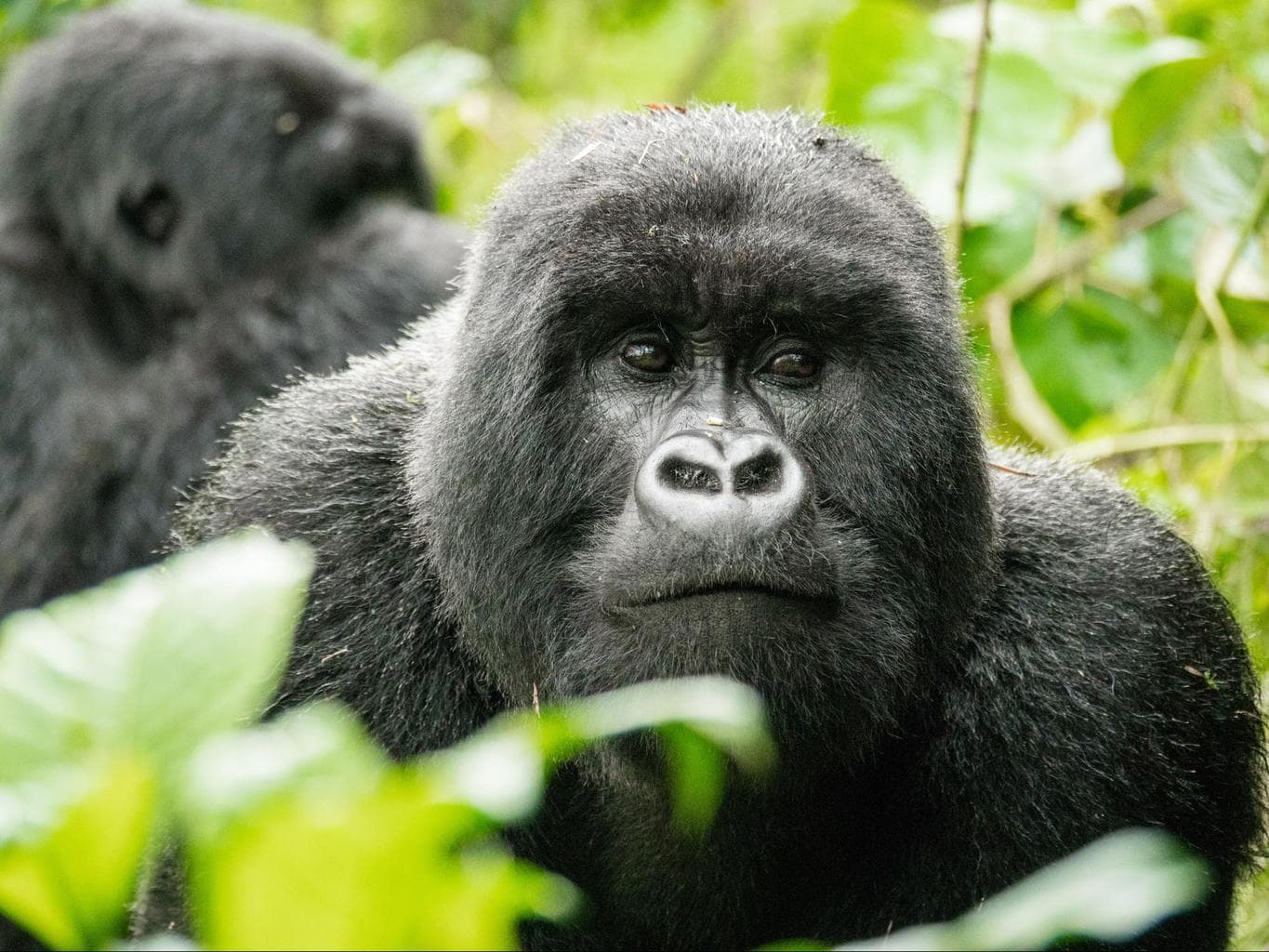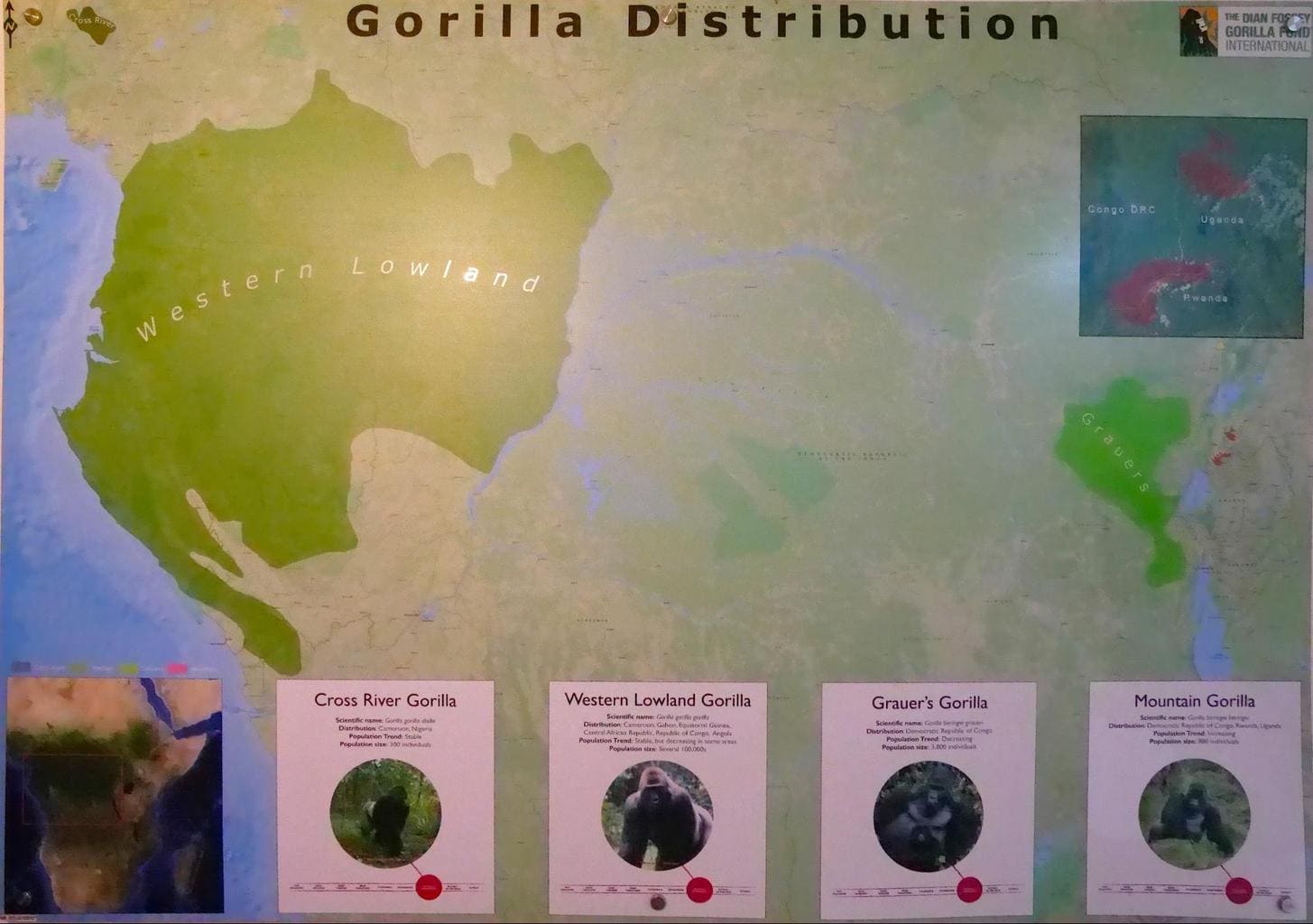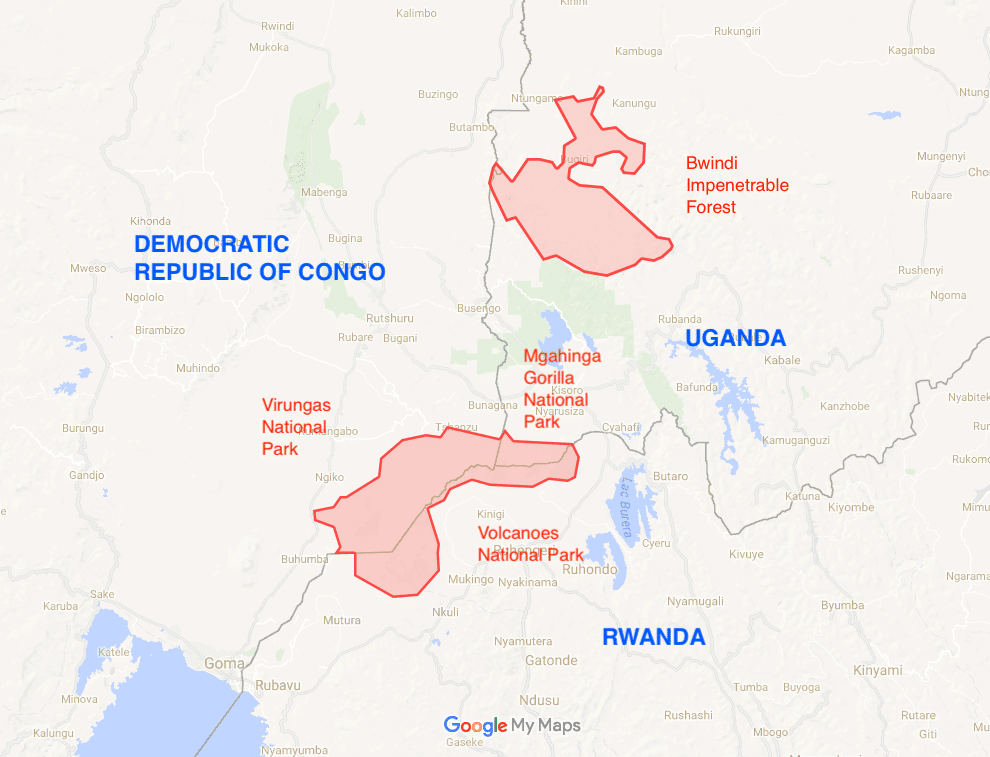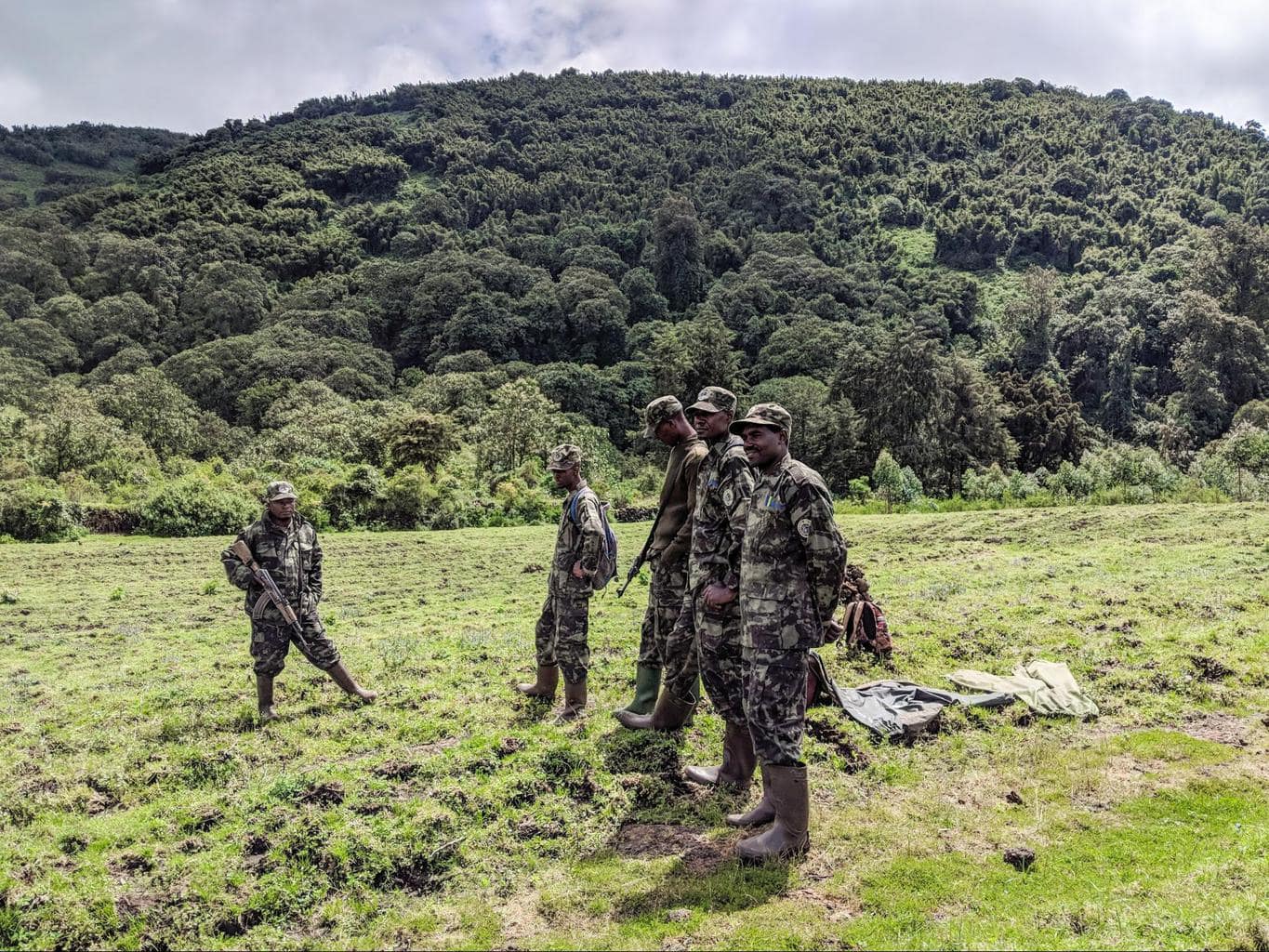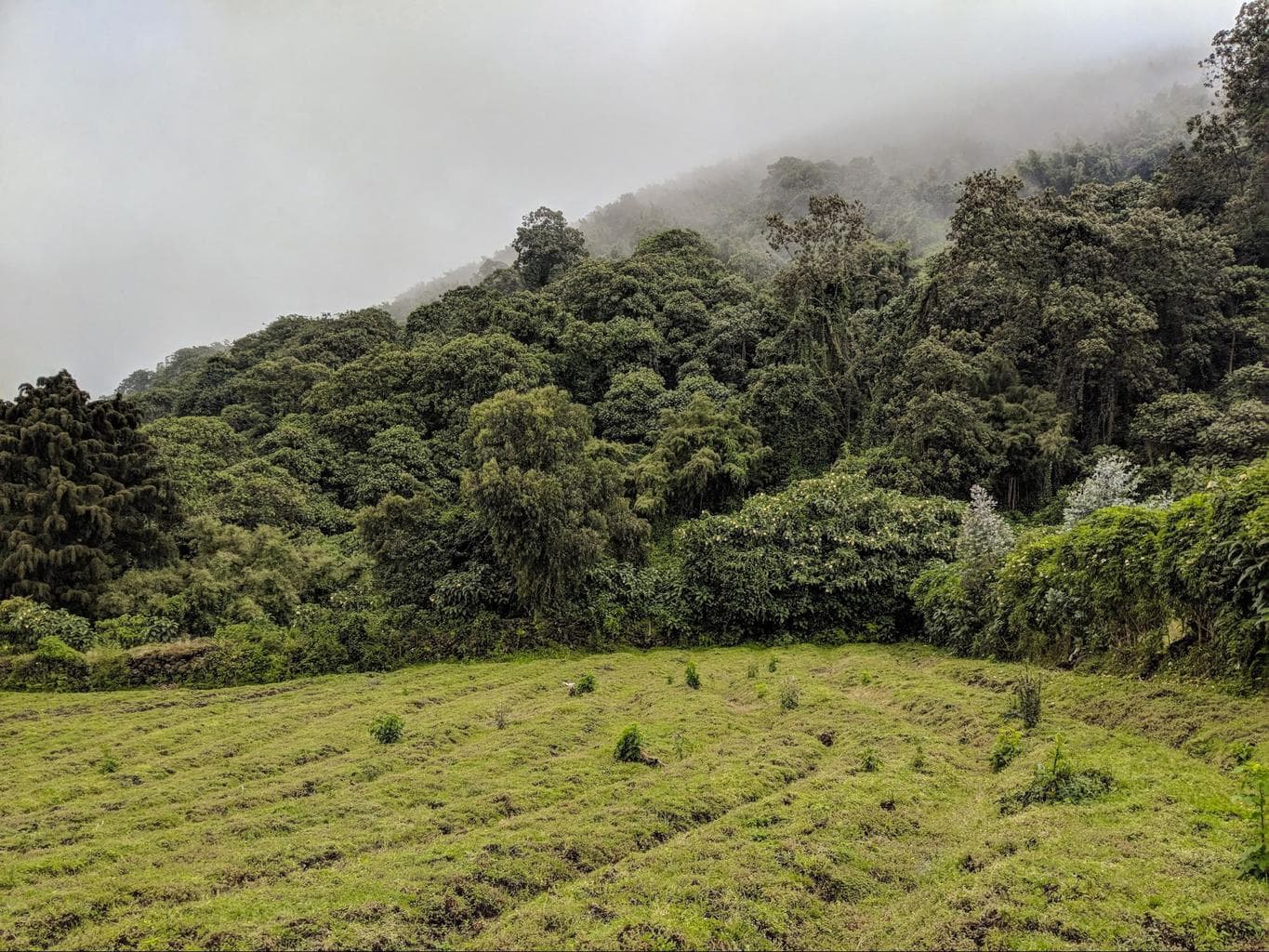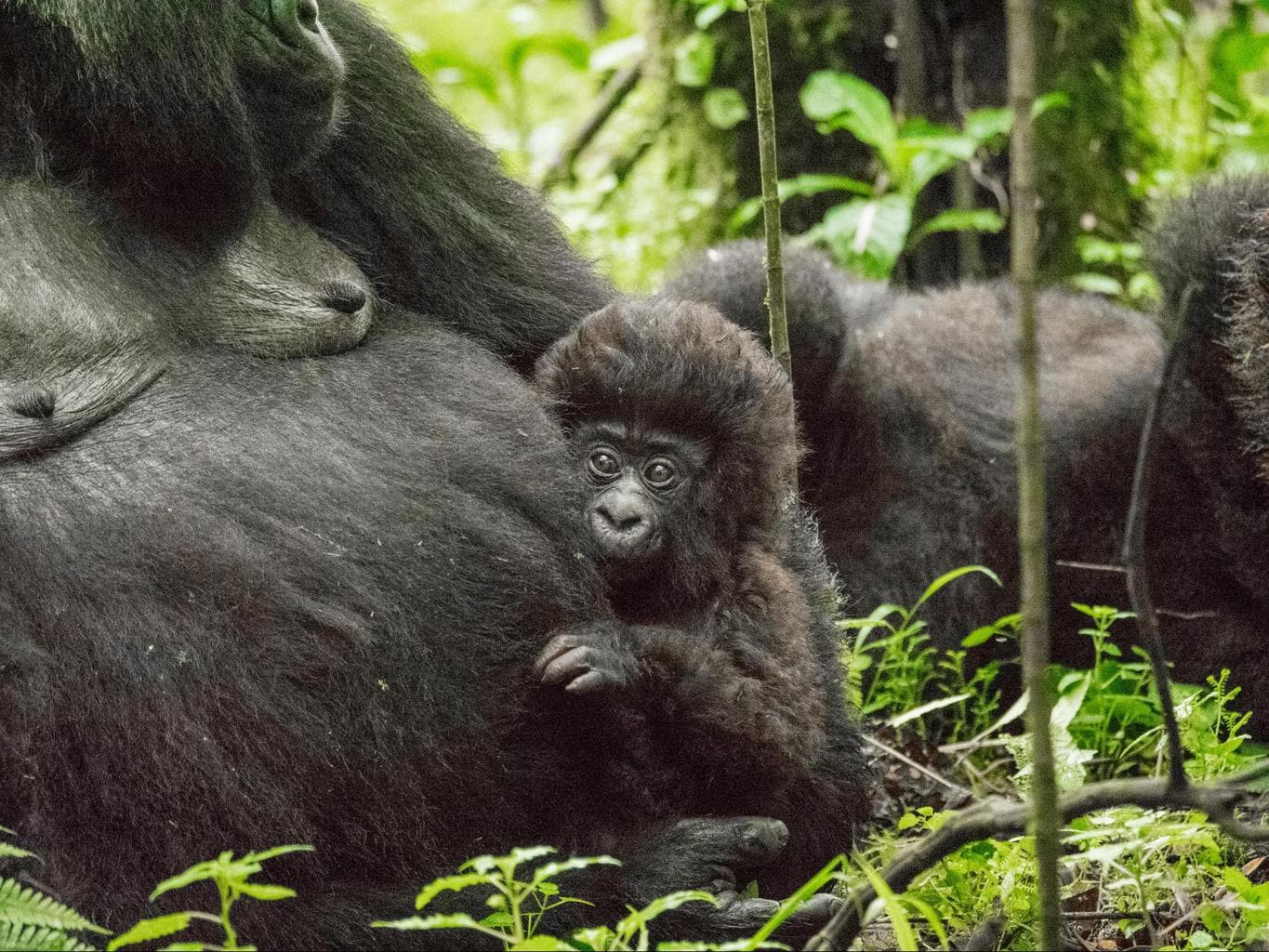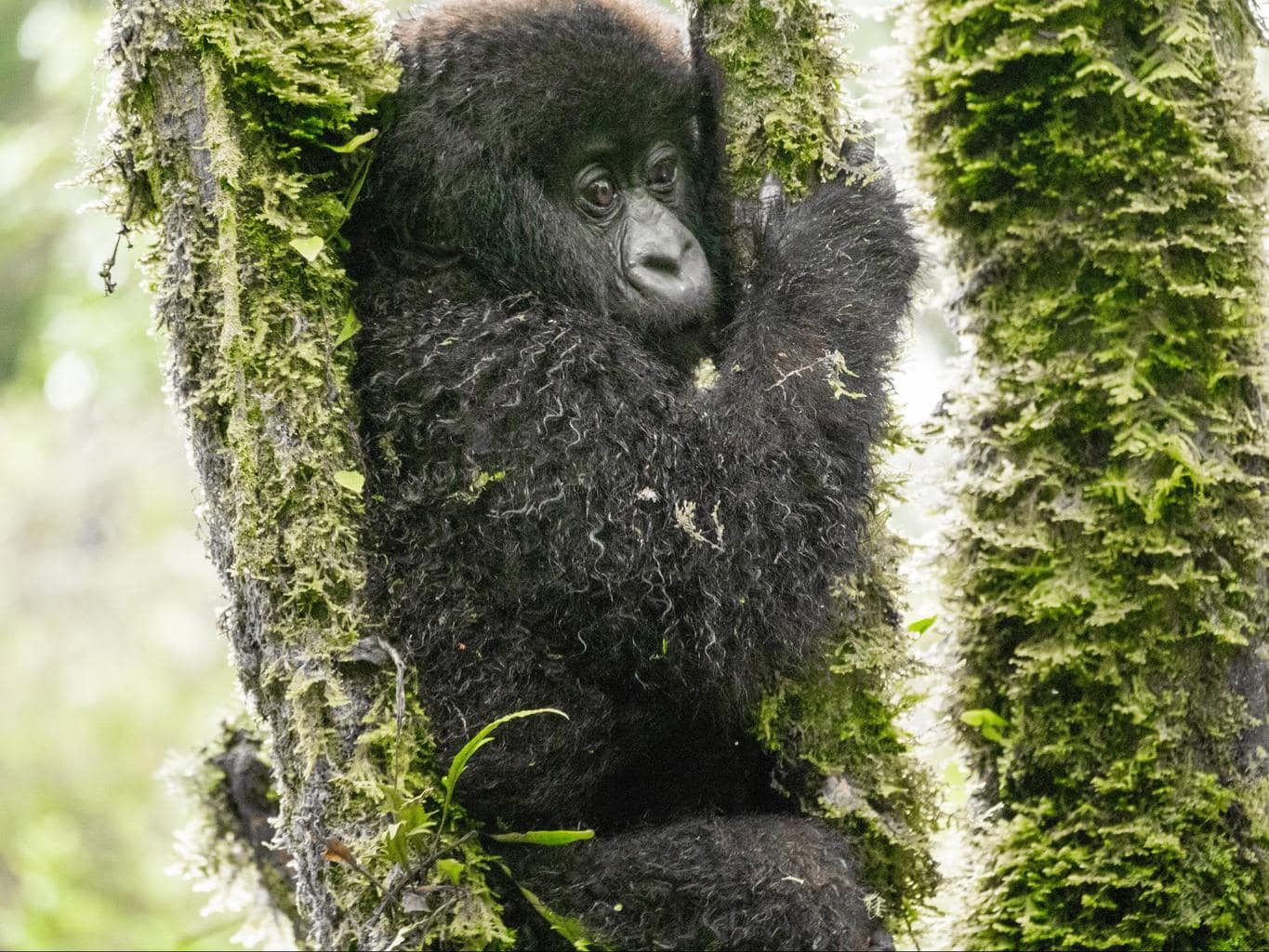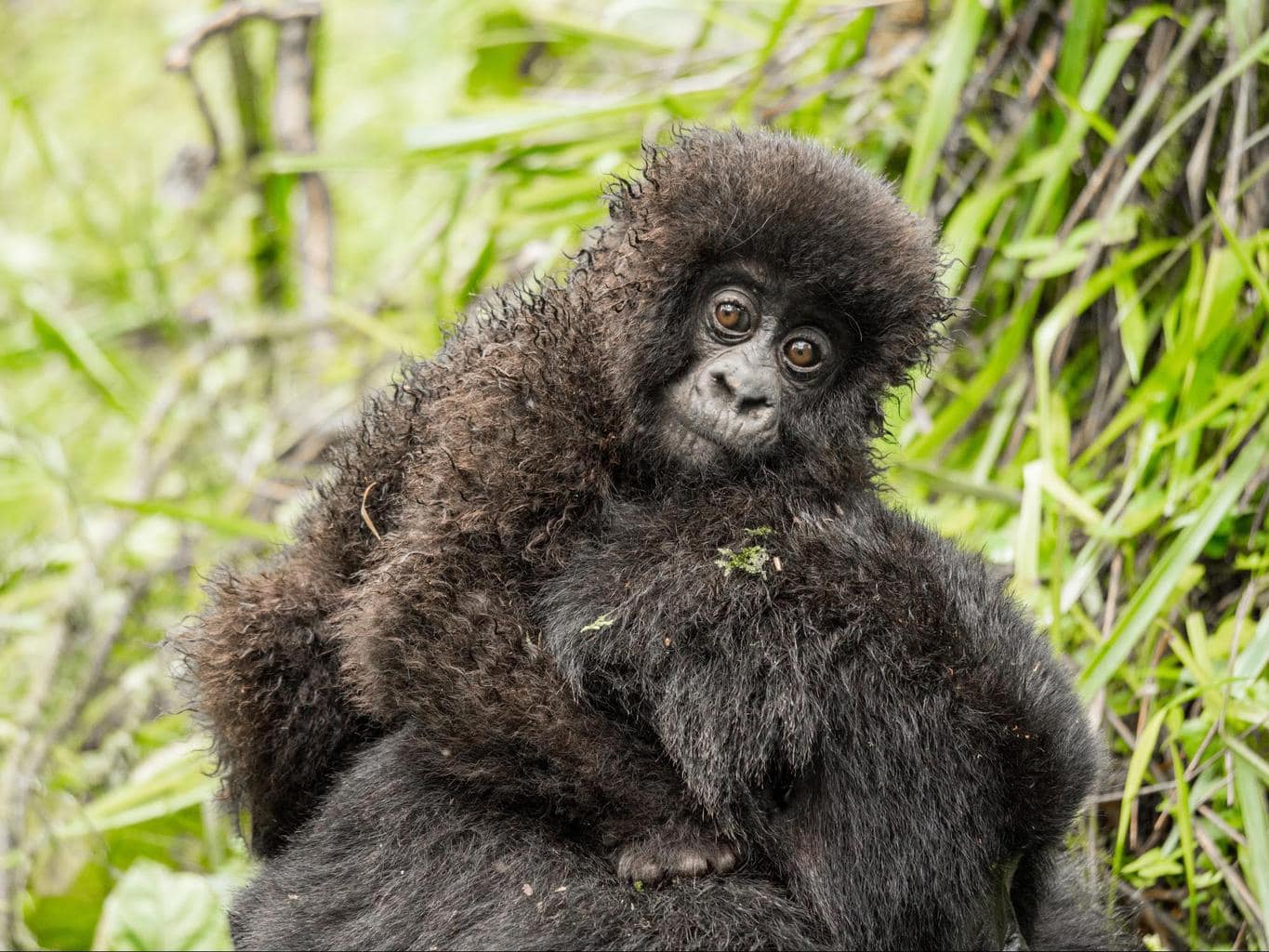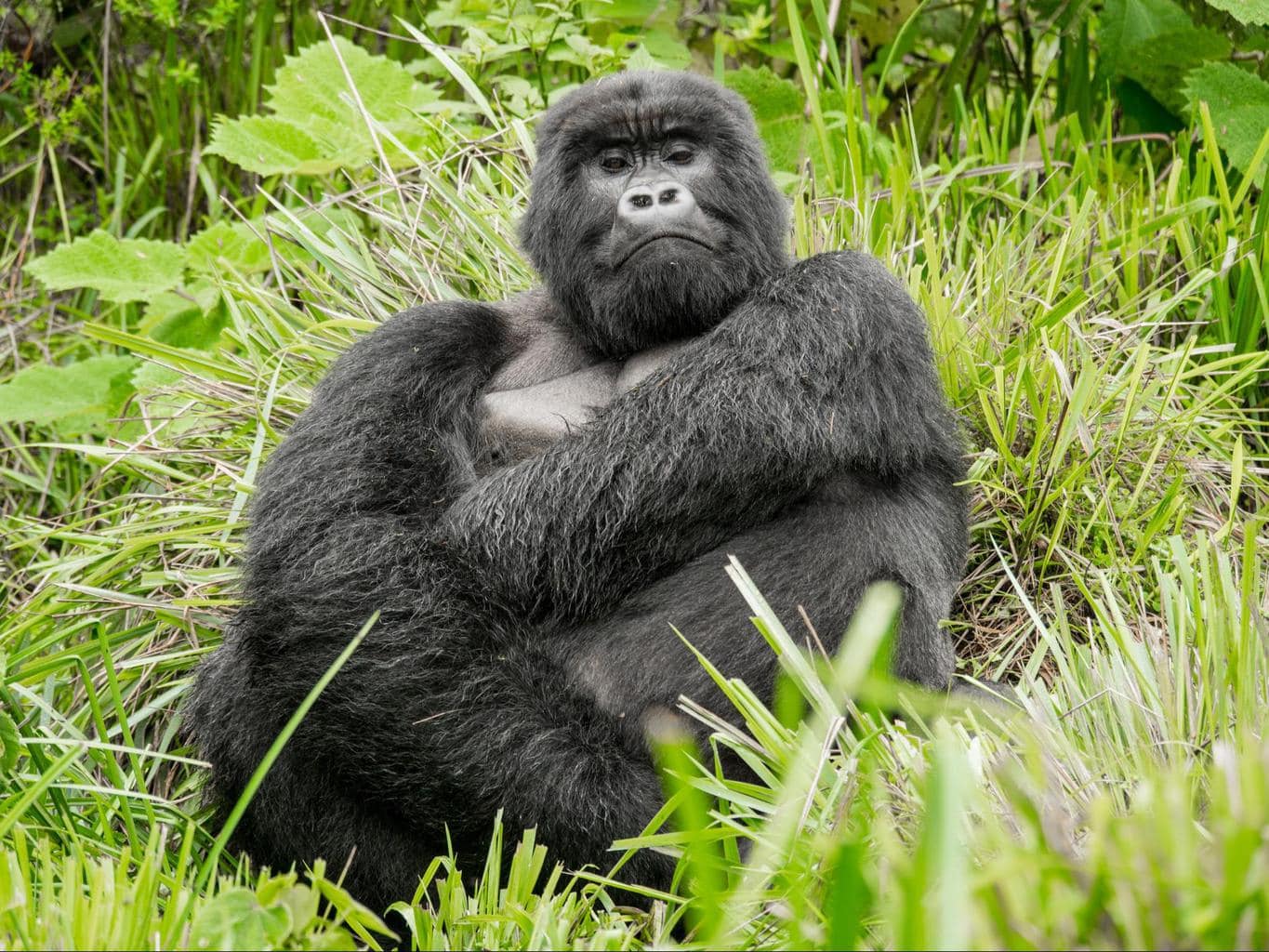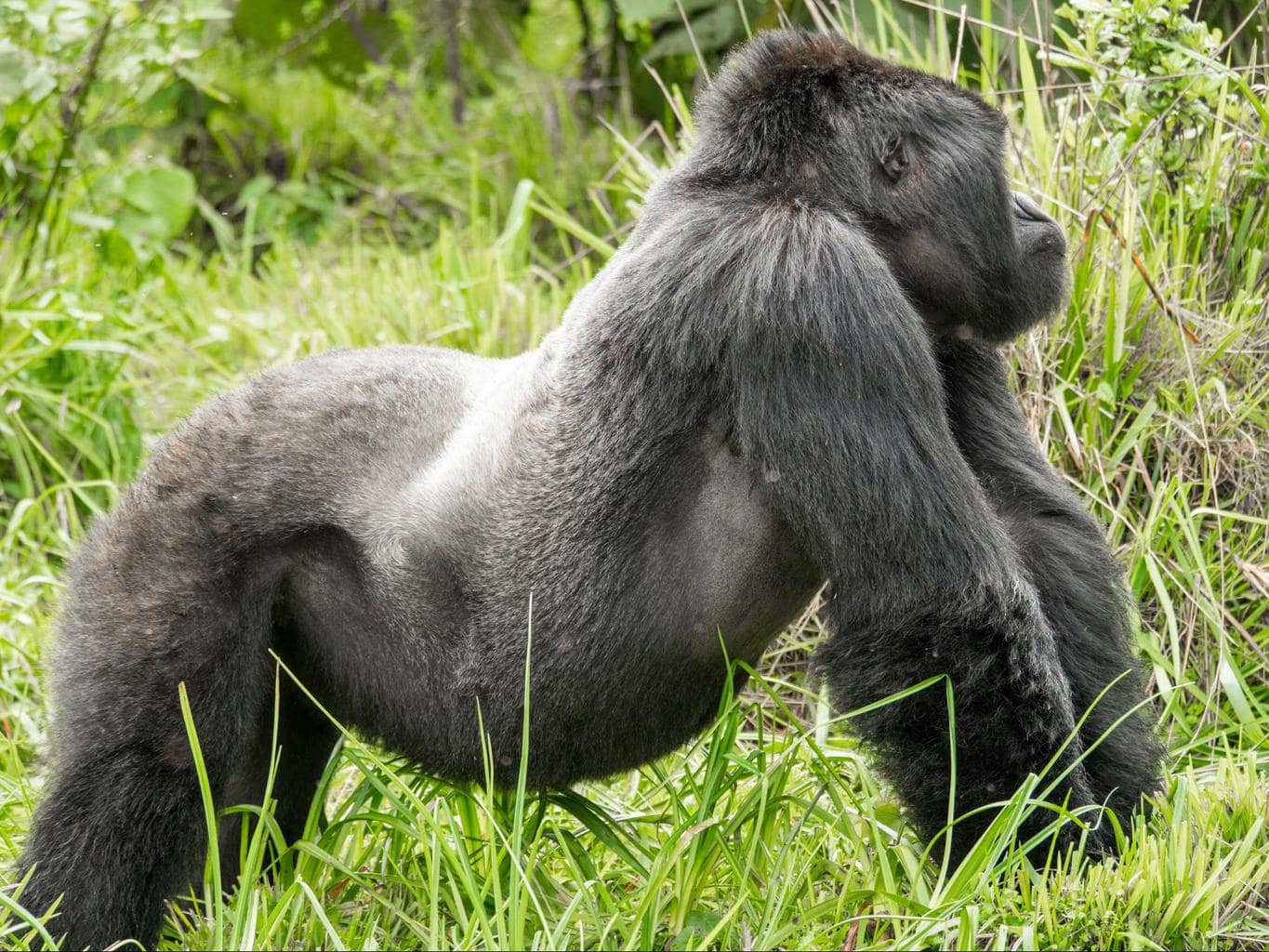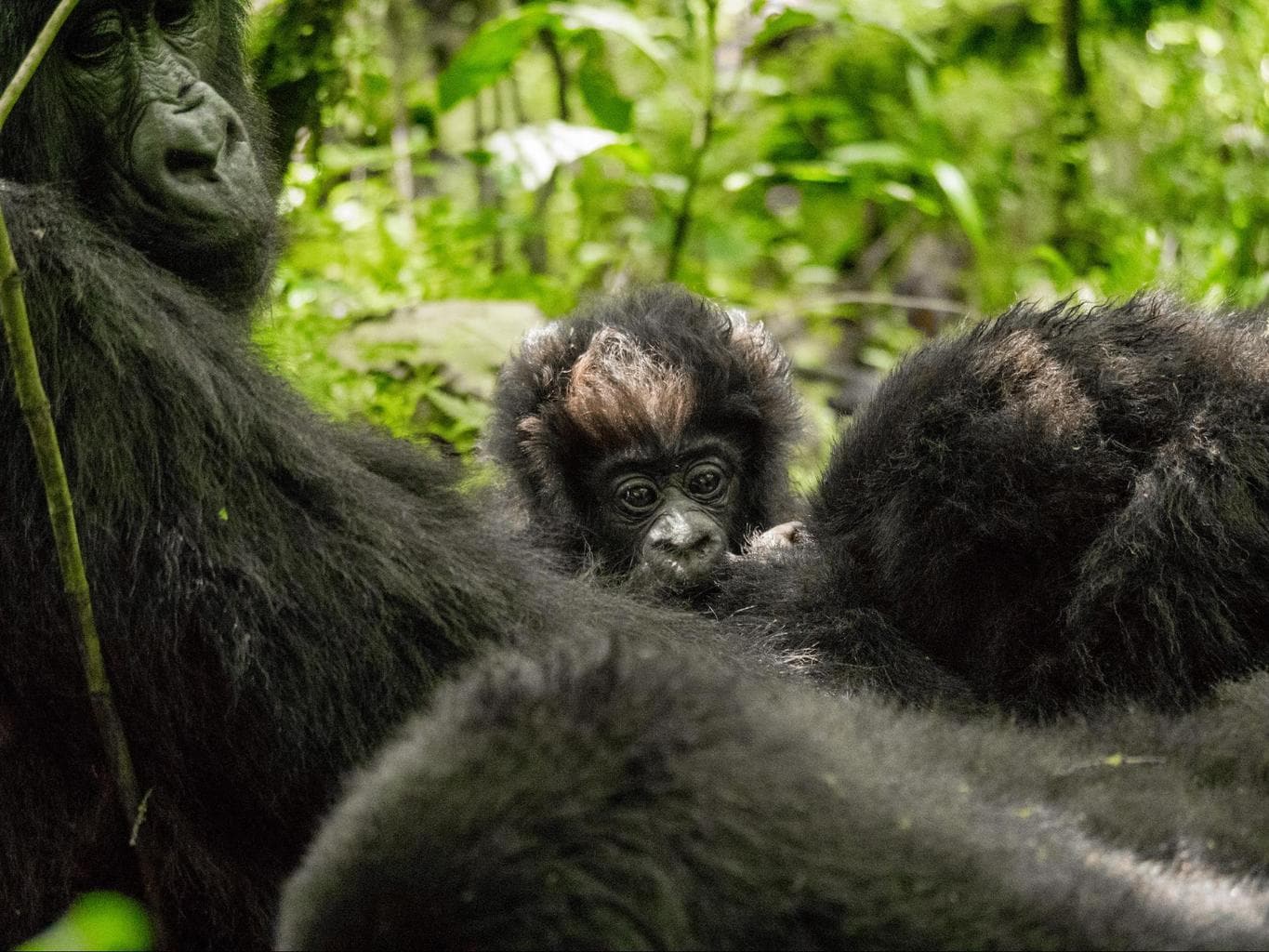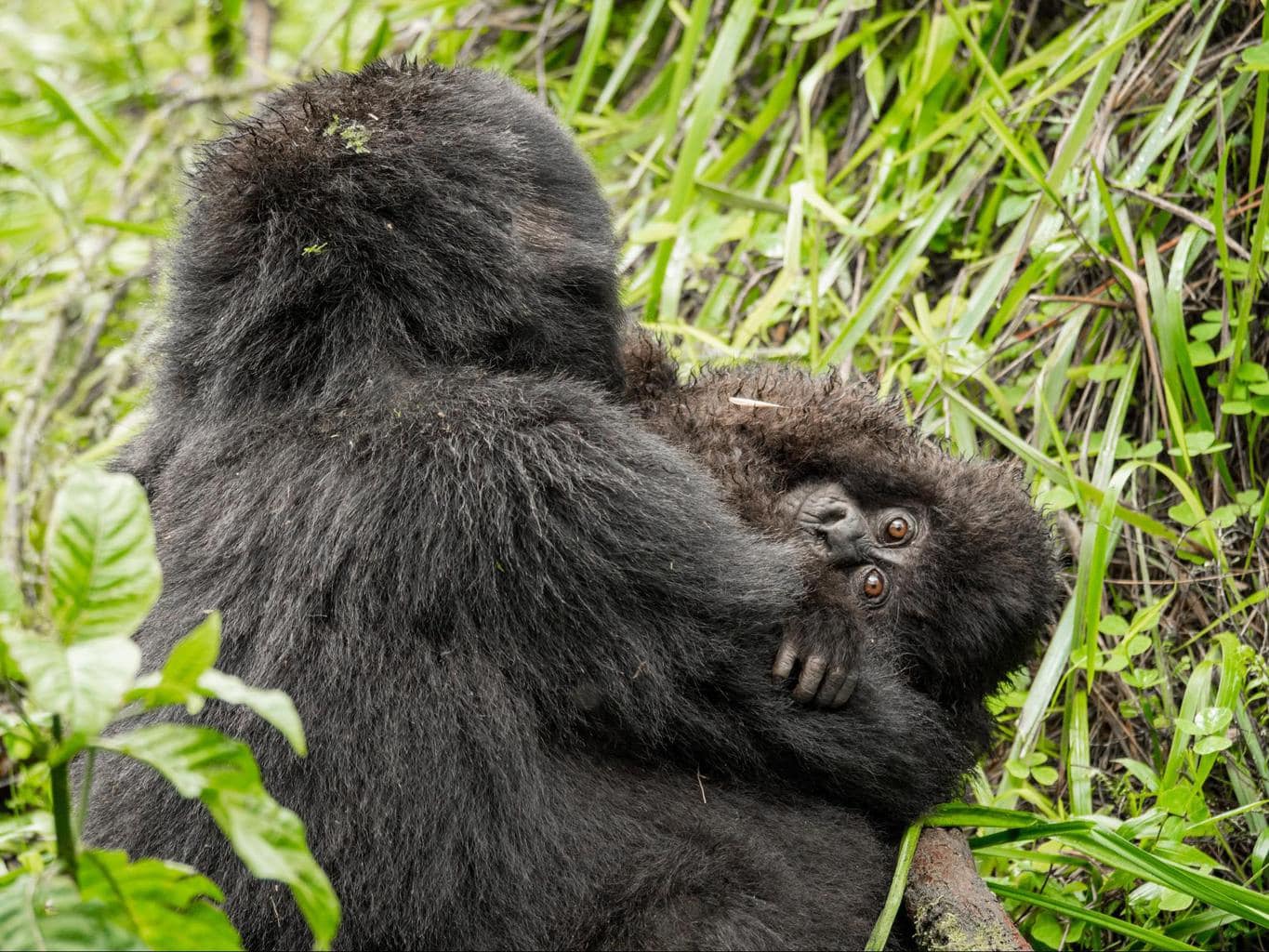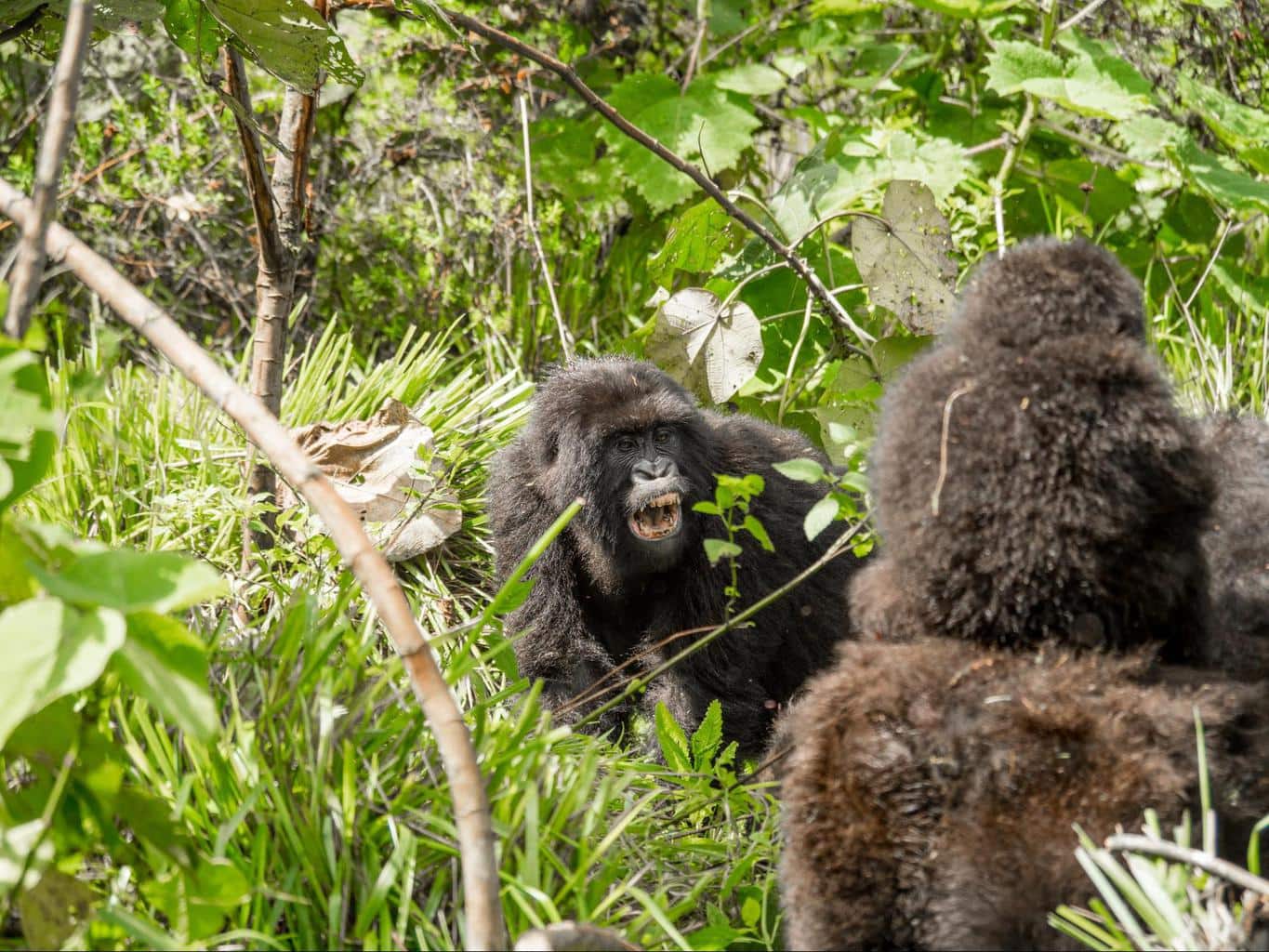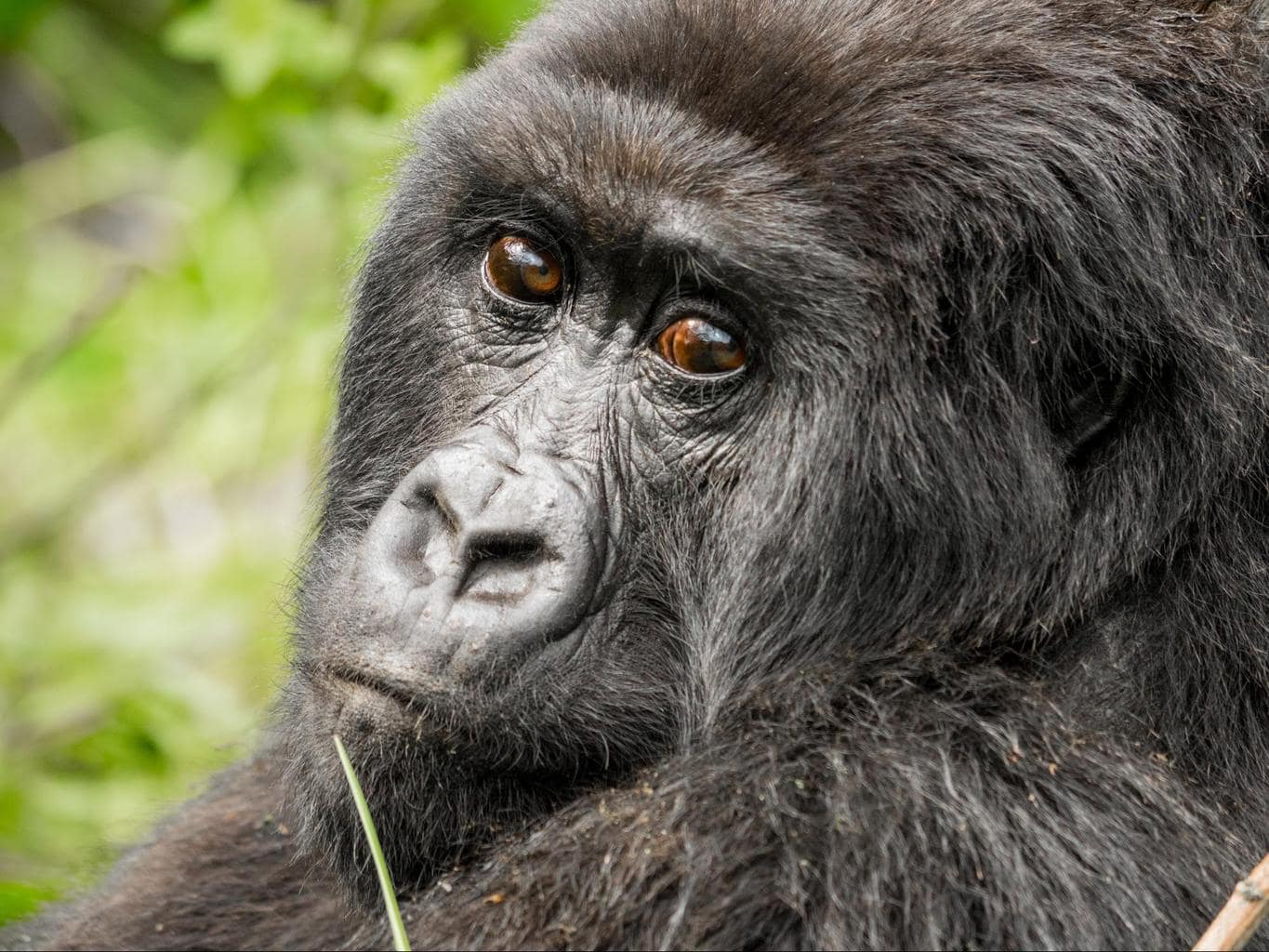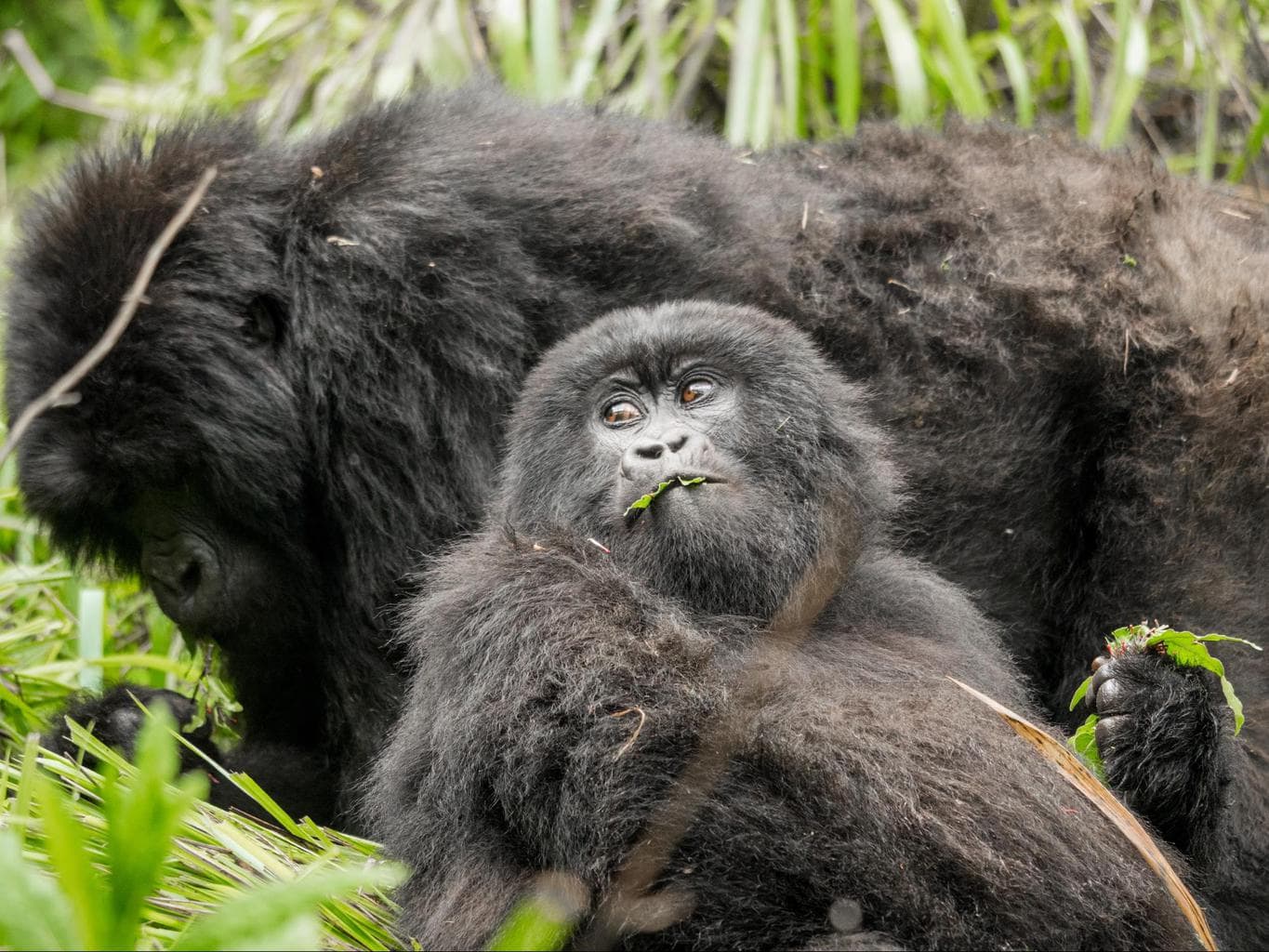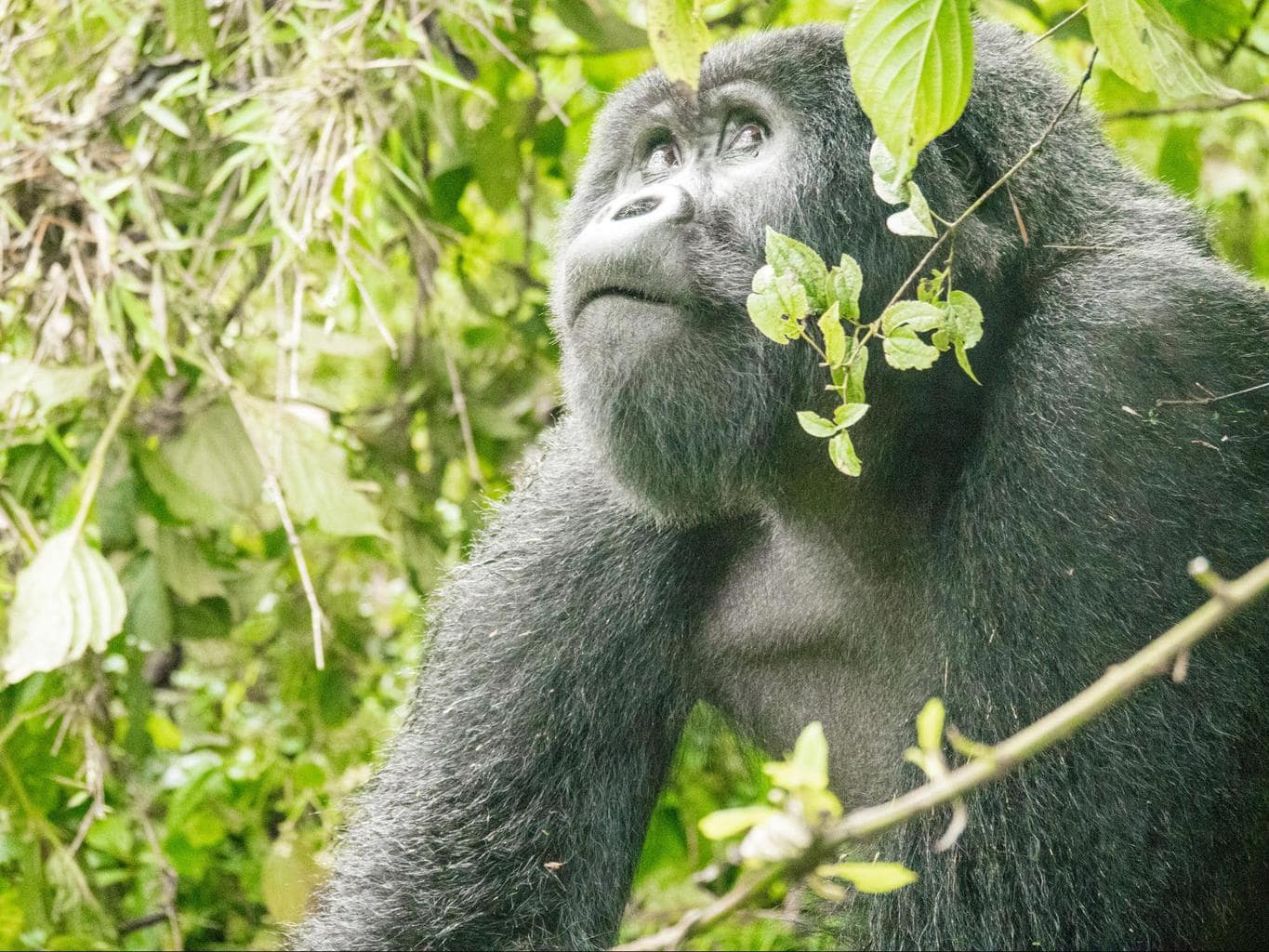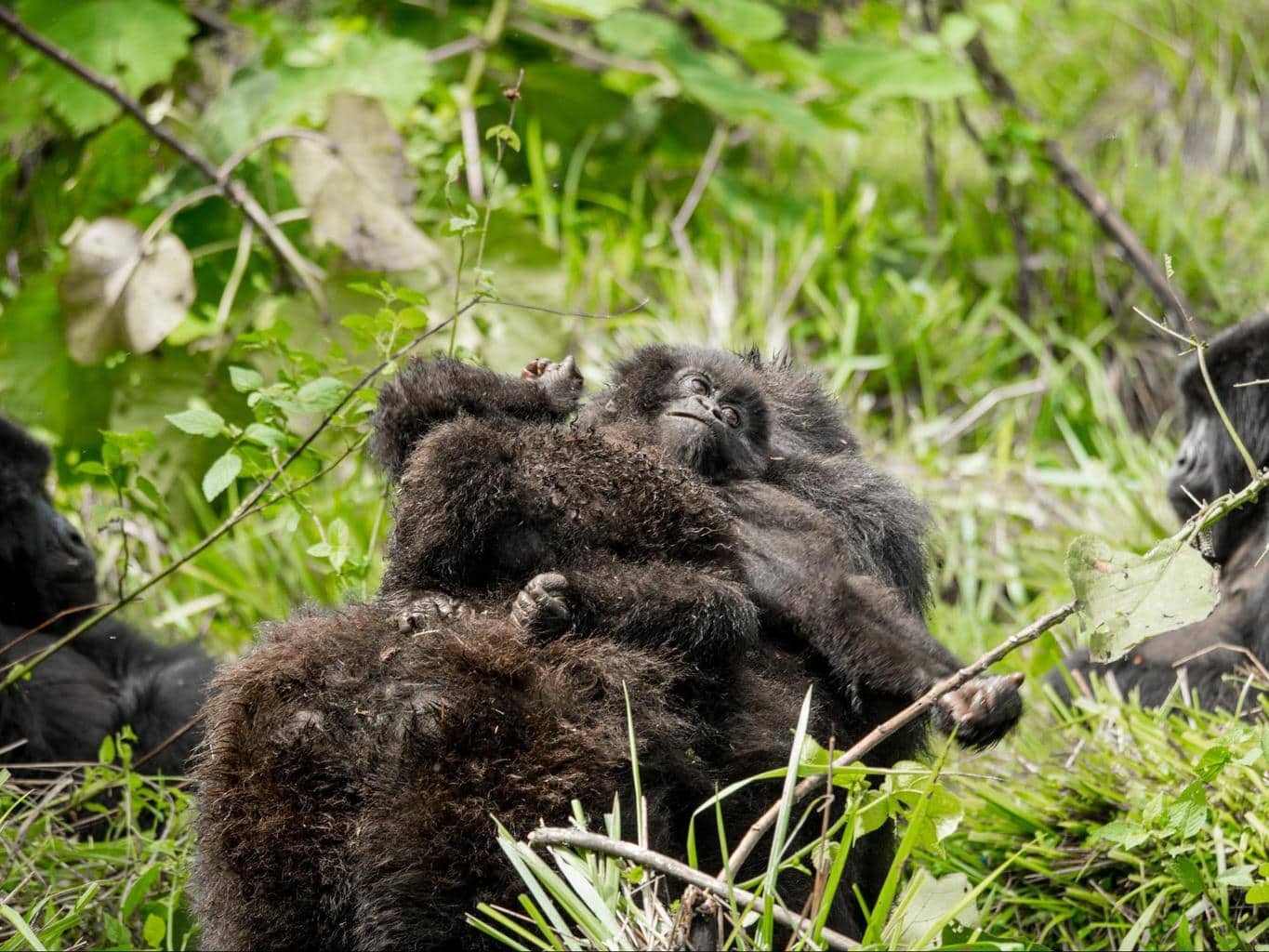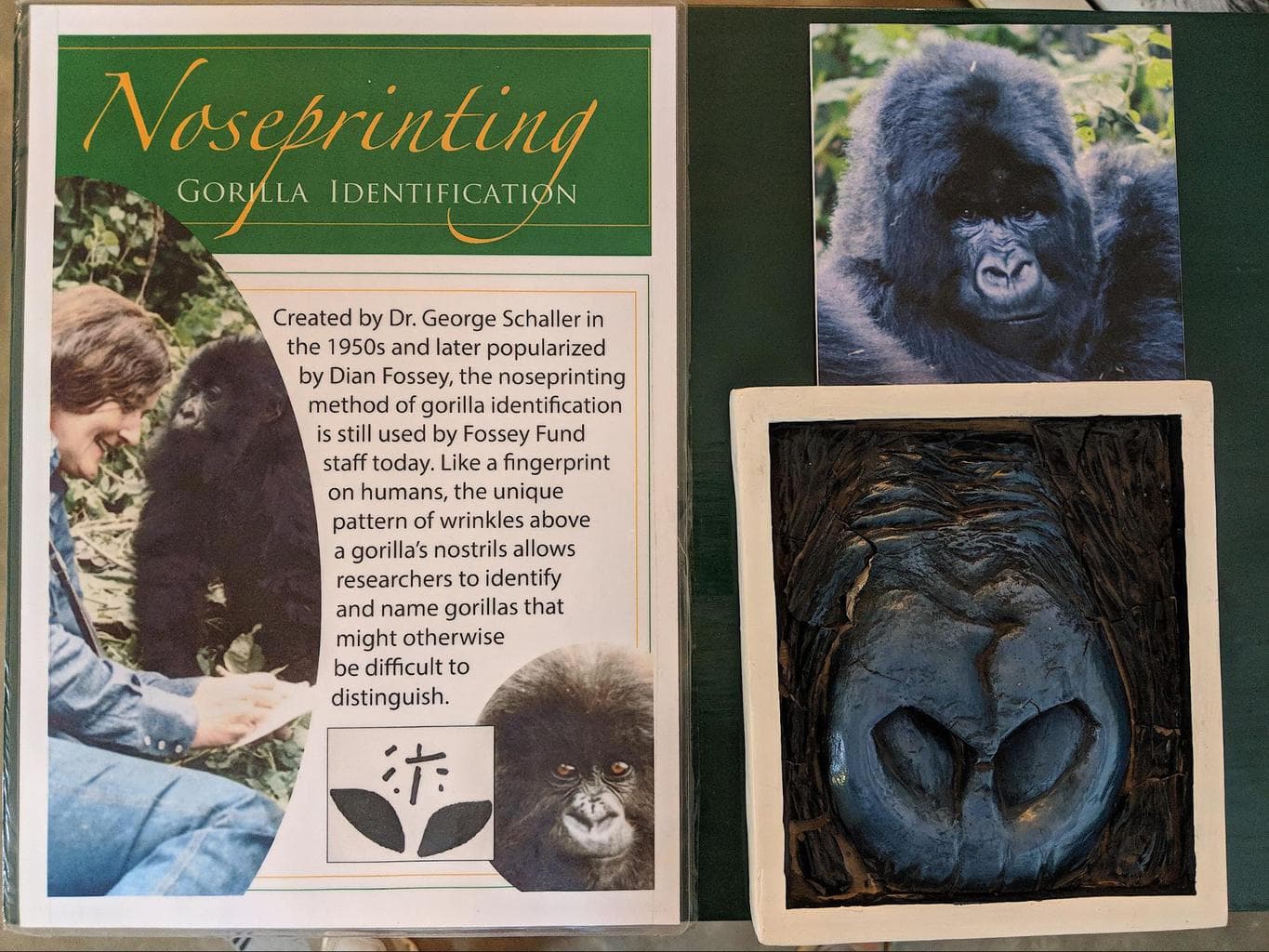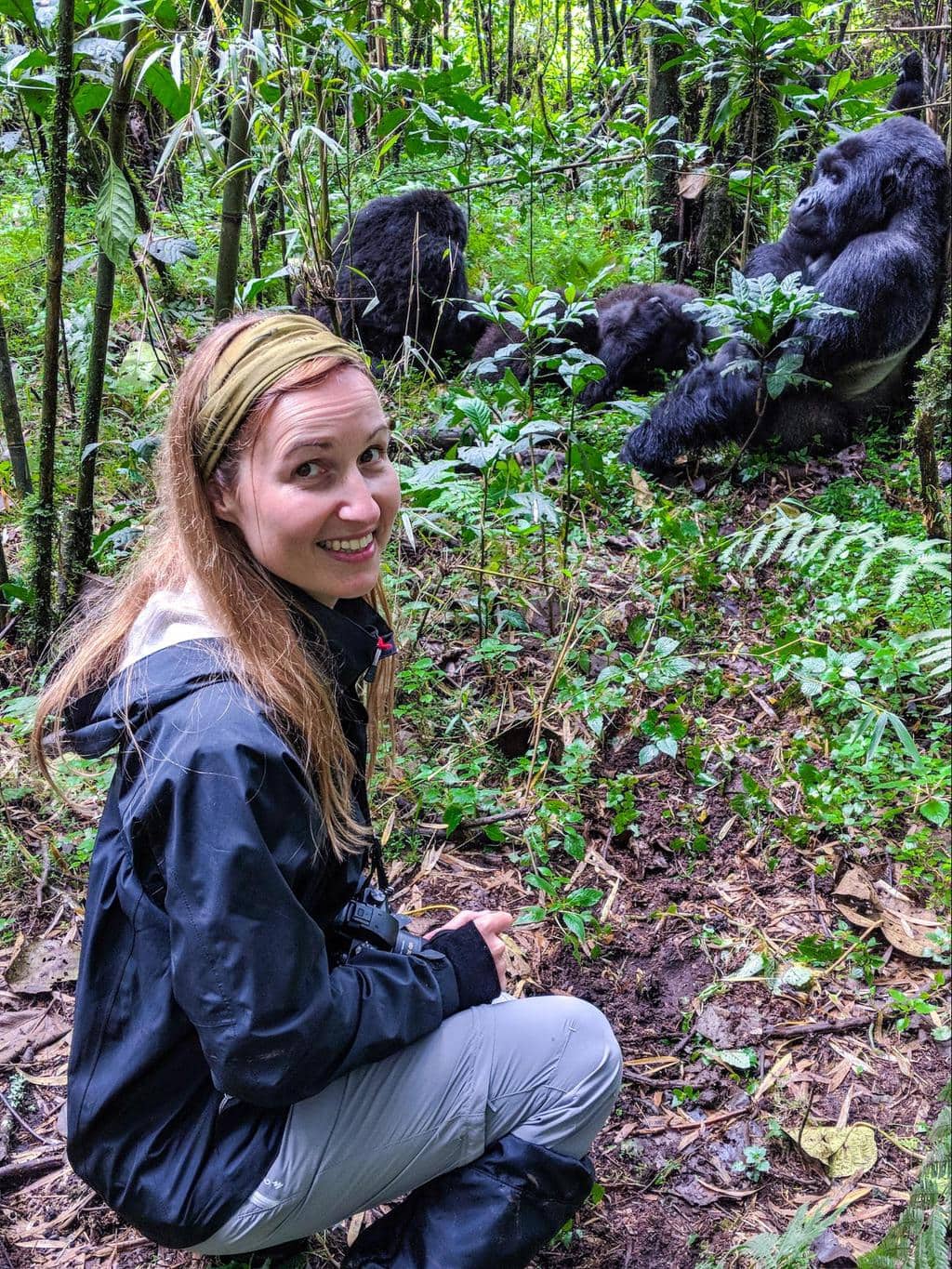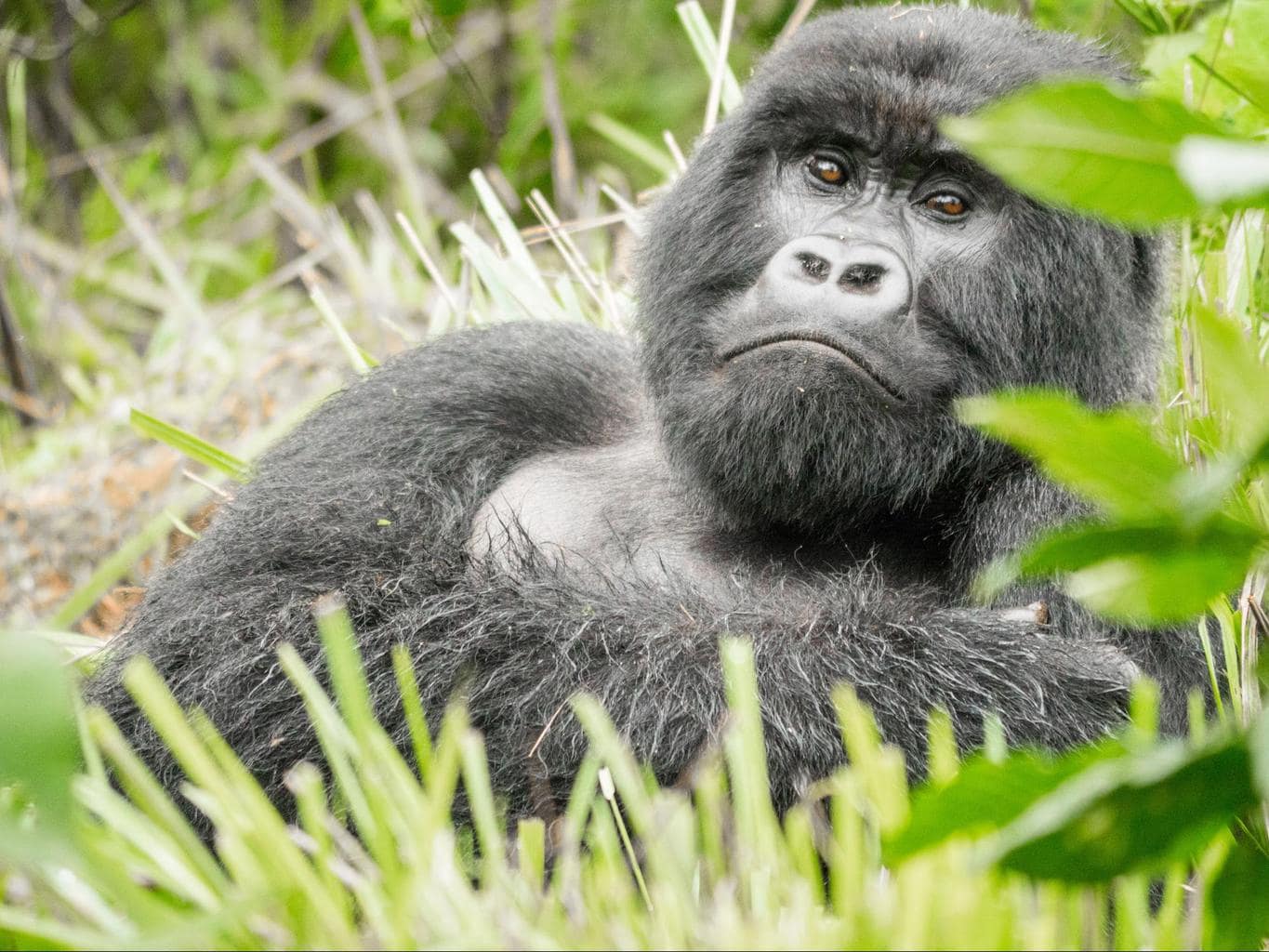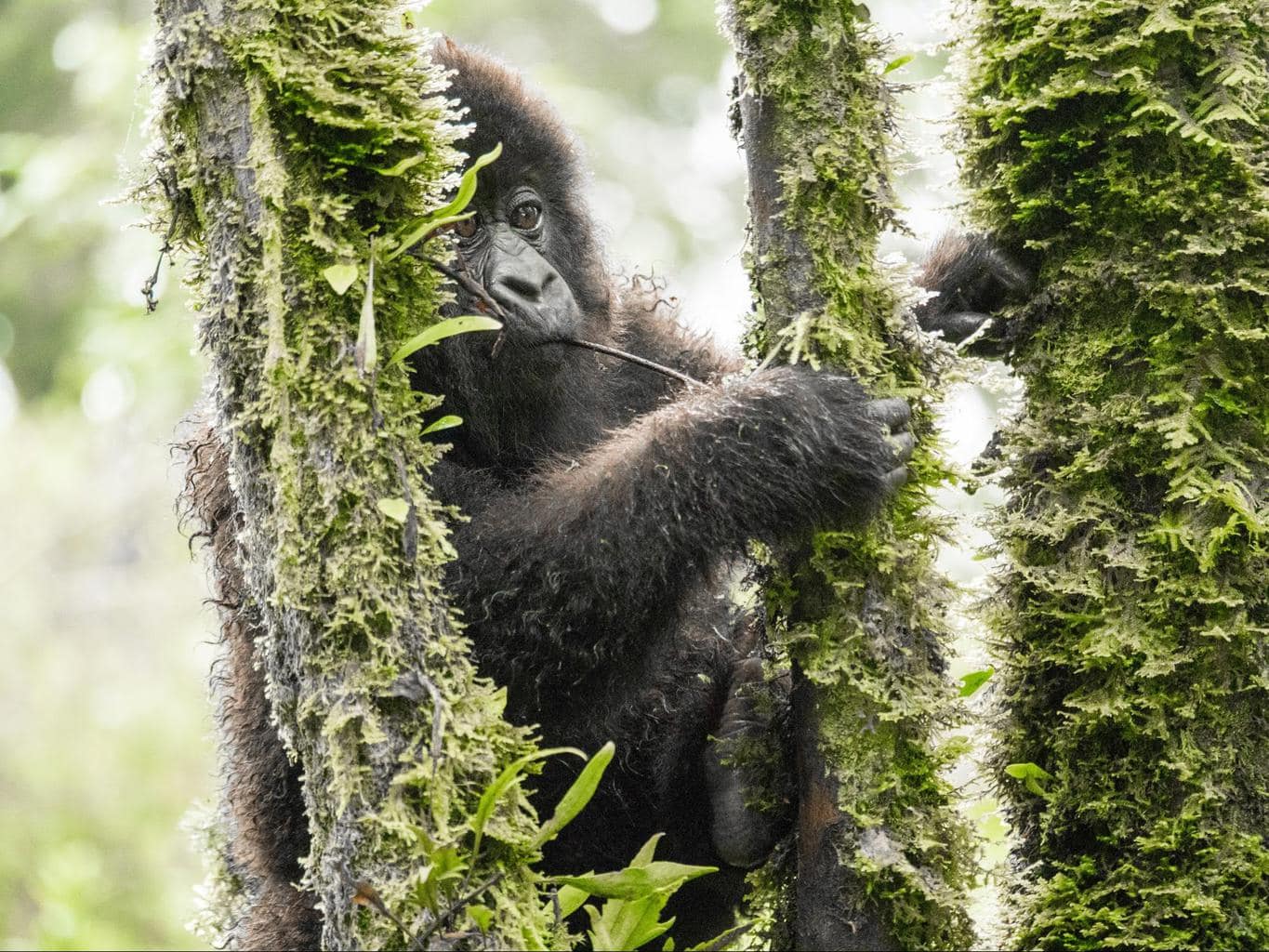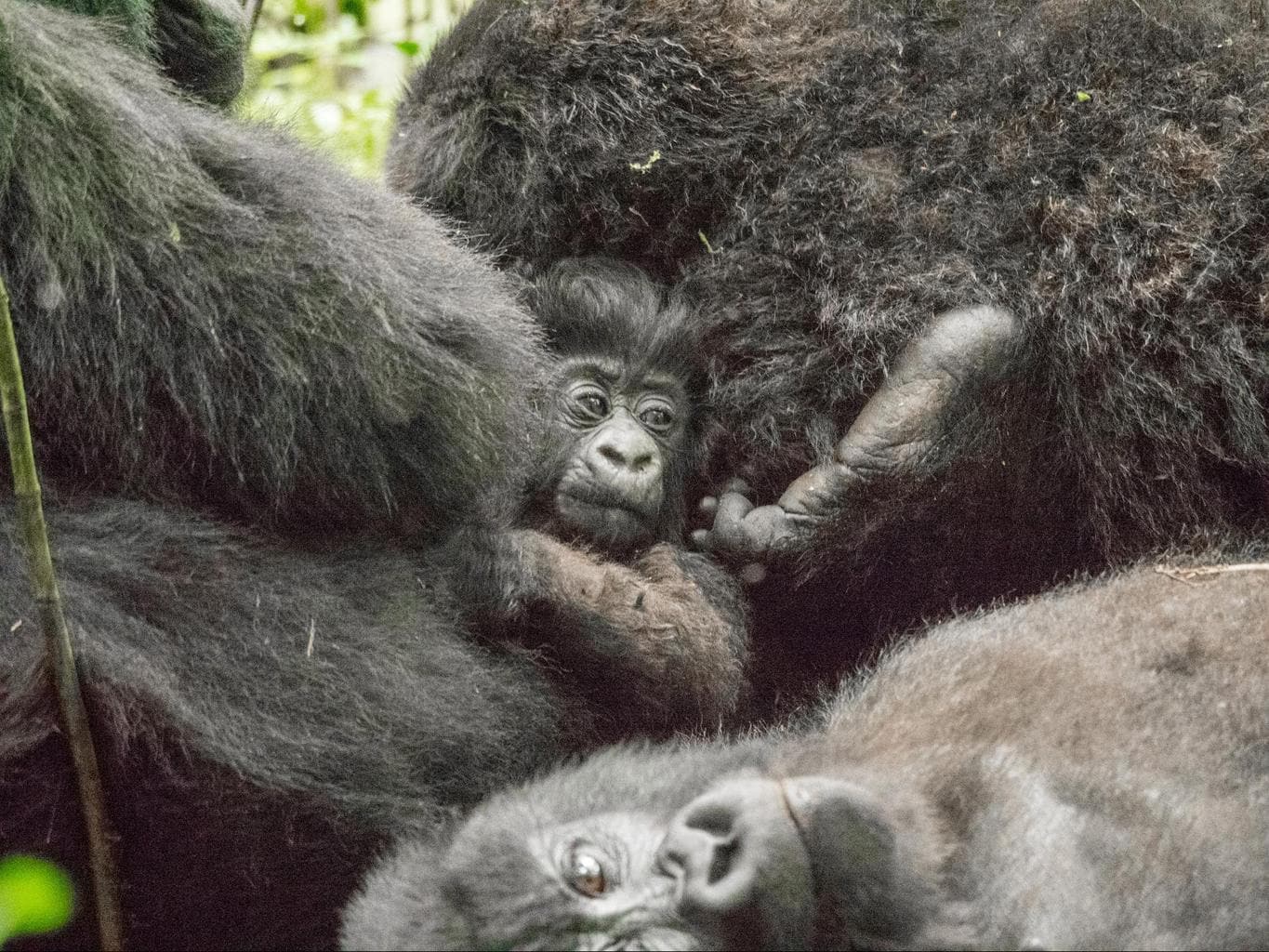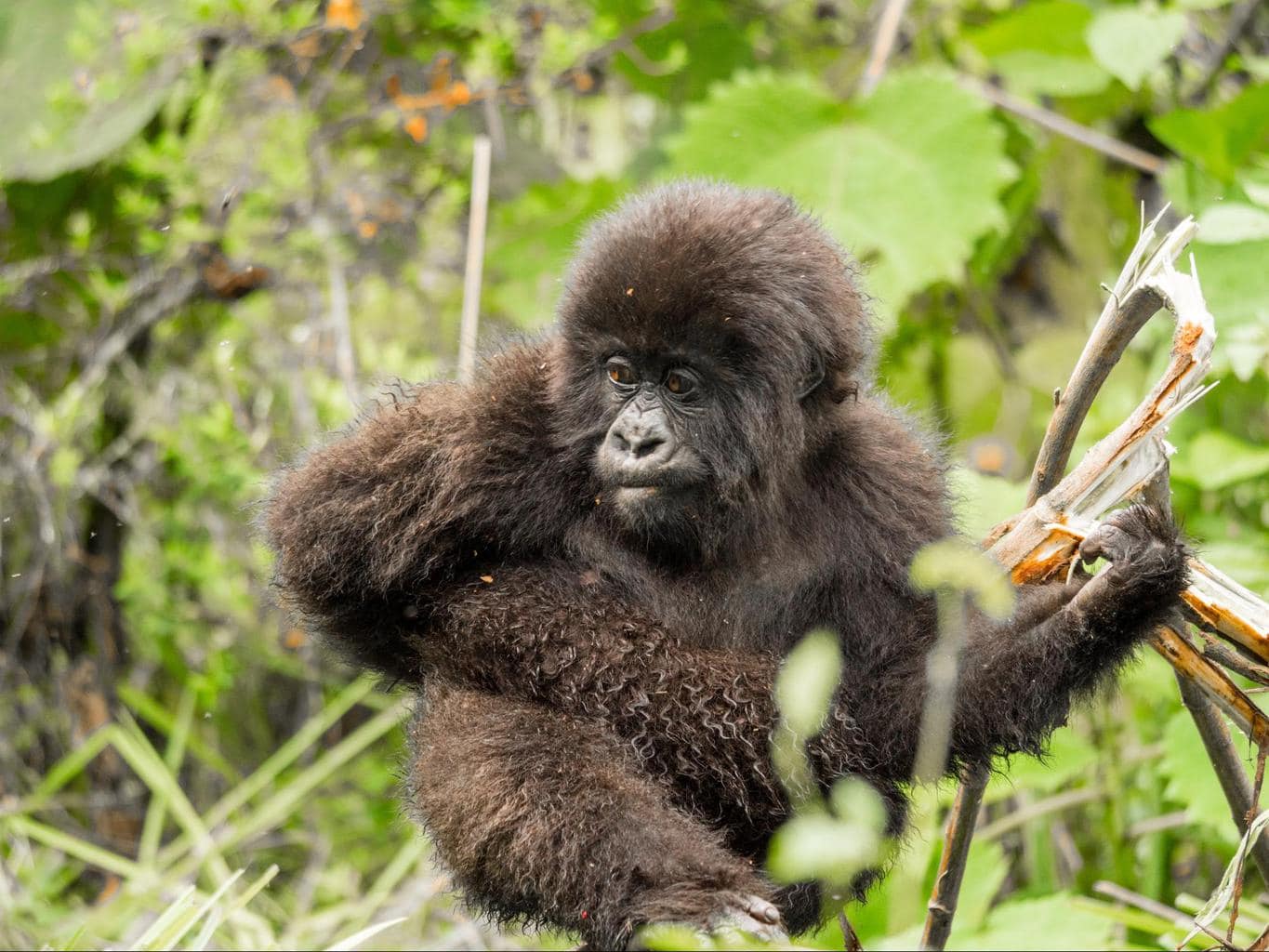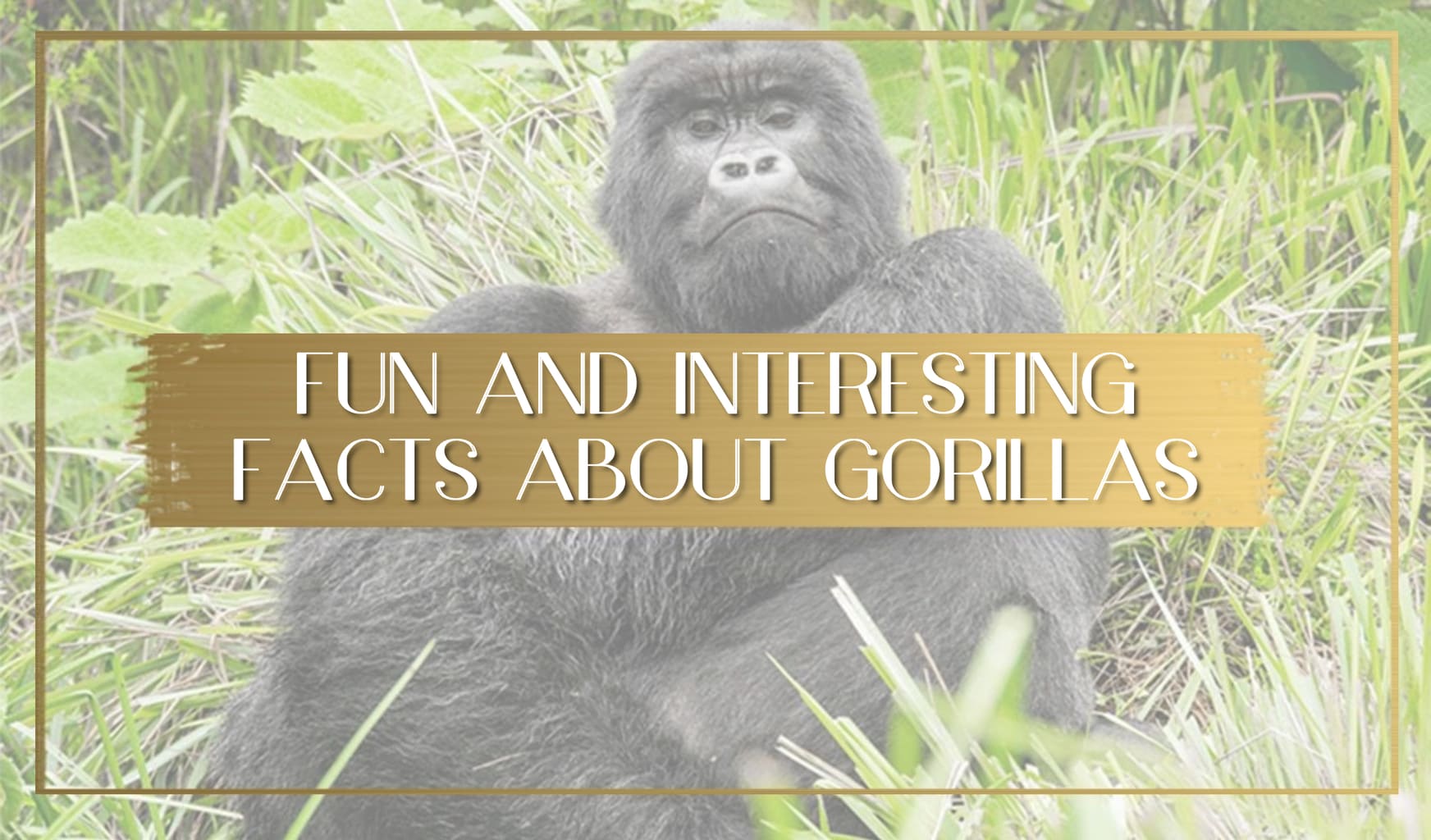
Did you ever wonder what gorillas eat? Do you know who the silverback gorilla is and what makes him different? Or who the mountain gorillas are? What about baby gorillas, would you like to know more about these adorable creatures?
Gorillas are some of the most enchanting and fascinating animals you will ever meet in the wild and an encounter in the forests of Africa is sure to be an extraordinary wildlife experience you will never forget.
But aside from the exhilarating feeling of coming up close with these large mammals, it is important to understand gorillas, their diet, their habitat, their threats to conservation and the many fascinating aspects that make them so interesting to us humans.
In this article I wanted to share some interesting facts about gorillas, tell you more about silverback gorillas, baby gorillas and everything that has to do with gorilla’s diet, their habitat and ecosystem, their history and discovery and also some fun gorilla facts that are sure to entertain everyone.
So here they are, 15 interesting gorilla facts and information to read before going on a gorilla trekking excursion in Africa. Did you know any of these gorilla facts? Tell me in the comments section at the bottom!
Here’s a video I made to summarise this article with footage of these gentle giants and the park rangers showing how to speak gorilla. The baby gorilla footage is my favourite!
1. Types of gorillas and where they live?
To start off, it is important to understand where gorillas live and where you can find them.
Although you may have heard of the more famous of the gorilla subspecies, the mountain gorilla, there are in fact two species of gorilla each with two more subspecies, living across nine countries in Central and East Africa. That means there are four types of gorillas and the mountain gorillas are just one of the four.
The map below shows where each subspecies of gorillas lives.
The two main species of gorillas grew at either side of the Congo River and are called Eastern Gorilla and Western Gorilla respectively. The Congo river probably acted as a natural barrier and the two gorilla species grew and evolved differently according to their habitat.
Eastern gorillas can be divided into the grauer gorilla, found mostly in the DRC, and mountain gorillas which live in Rwanda, Uganda and the DRC and have been the longest and most thoroughly studied of the subspecies thanks for the work started by Leakey and continued by Fossey.
Both eastern gorilla subspecies can be differentiated by the length and thickness of their hair. Mountain gorillas need thicker and longer hair to protect themselves from the colder higher altitude of the Virungas National Park, The Volcanoes National Park, Bwindi Impenetrable Forest and Mgahinga Gorilla Park.
Western gorillas can either belong to the lowland western gorilla subspecies living mostly in the Cameroon, Gabon, the DRC, Congo, Angola or Equatorial Guinea. Or there is the cross-river gorilla, inhabiting the area on the border between Nigeria and the Cameroon and perhaps the least studied, tracked or visited of all the gorilla subspecies.
Although the four subspecies are quite similar, they can be differentiated by their size and appearance something which is largely the result of their habitat and adaptation to the environment.
2. Why are gorillas endangered?
Unsurprisingly and as expected, the four subspecies of gorilla are all considered critically endangered by the International Union for Conservation of Nature (IUCN). That means that their future is fragile and they are at imminent risk of disappearing if measures to preserve them are not put in place.
As per the IUCN, when a species is critically endangered there is a high risk of extinction in the wild. The critically endangered classification is just one level before complete extinction. Species that go without conservation efforts put in place become extinct in the wild and eventually extinct all together.
The following chart created by the IUCN shows the various wildlife classifications.
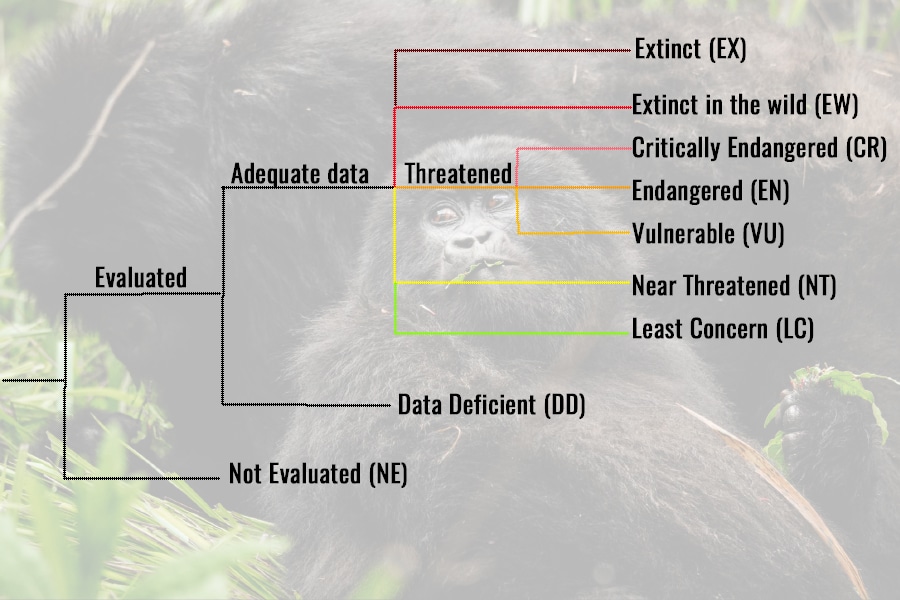
Although all four subspecies of gorilla are critically endangered, the number of gorillas left in the wild varies significantly by subspecies. While there are only 300 cross-river gorillas and 3,800 Grauer gorillas left, there are still over 350,000 western lowland gorillas estimated to live in the wild, although numbers are unclear given their isolation and limited research and conservation personnel.
Mountain gorillas were in very low numbers when famous scientist Dian Fossey started studying them in the 1960s but are the only gorilla subspecies which is slowly increasing in number thanks to solid conservation efforts across the DRC, Rwanda and Uganda led by the Dian Fossey Gorilla Fund Foundation and the Karisoke Research Center. The latest census in the Virungas Massif in 2018 showed that there are 604 mountain gorillas in the wild parks of the DRC and Rwanda, that is 25% more than in 2010. When adding the count from the latest census in the Bwindi Impenetrable Forest, the total population of mountain gorillas is just over 1,000 individual animals.
Gorillas are endangered for several reasons.
- The first one is the threat coming from loss of habitat as a result of human development.
- Secondly, there are the deaths derived from man-animal conflict.
- Thirdly, gorillas are being hunted for their meat or as trophies and caught in snares. The ongoing conflict in the DRC has also claimed several gorilla lives.
- Lastly, diseases are also a threat to gorilla populations across Africa, especially ebola and other illnesses that we have become immune to but gorillas haven’t. Let’s look at each of the reasons why gorillas are endangered in detail.
Gorilla’s loss of habitat has been caused by uncontrolled logging, mining projects and subsistence farming by the communities living in and around the parks where they live. During the Rwandan genocide and conflict between 1990 and 1994, refugees who escaped to the Virungas National Park had to live off the forest, cutting down a lot of the trees and vegetation that made the gorilla’s habitat. Farmland has also been expanding and encroaching on the gorilla territory across all three countries.
The conflict between humans and animals has also caused gorilla deaths, especially in the past. The creation of the park sanctuaries where no human communities inhabit, has provided some relief but there is nothing stopping gorillas from getting out of the park. In Rwanda outside from rural capital Kigali, the stone wall encircling the Volcanoes National Park is no more than 1.5 meters high and farmland is right at the footsteps of the park. Gorillas are often seen wandering in the fields eating the crops.
Gorillas are also being hunted for their meat to eat, especially in the Virungas National Park where militia living in gorilla territory kill gorillas for food. Bushmeat is a highly prized meat in the cities where it is considered a high end and exclusive meal. Gorillas are also hunted and captured as trophies and sold into the illegal trade where some of their parts are used in traditional medicine and baby gorillas are traded as pets.
The ongoing conflict in the DRC has put enormous pressure onto the Virungas National Park, its rangers, guides and its gorilla population with deaths of all groups involved occurring regularly.
Lastly, gorillas also die because of diseases. Since the 1990s, Ebola has claimed the lives of many gorillas and wiped out complete populations in Minkébé in Gabon, and Odzala National Park in the Republic of Congo which are slowly growing in numbers.
Given gorilla’s slow reproduction cycles and the fact that female gorillas have very few offsprings in their lifetime, means that their growth is very strongly influenced by their death rates and a bad strike of a disease or a conflict exploding in an area can make entire gorilla families extinct.
3. Who are the Mountain gorillas?
Mountain gorillas, the most famous of the four gorilla subspecies and the most commonly tracked and habituated, were not known to the outside world until a German Army Officer named Captain Robert von Beringe killed two in the jungles of Congo in 1902.
The explorer was on his way to meet the Sultan Msinga of Rwanda in the Virungas National Park when he saw one in the wild. The Officer’s name was given to the animal which is scientifically known as gorilla beringei beringei in his honour.
One of the specimens he killed, minus the skin and one hand which were taken by a hyena, were sent to Berlin for study. This is how a new gorilla subspecies was discovered.
The first gorilla ever seen alive in the wild before that was found by Paul Du Chaillu in his travels through western equatorial Africa from 1856 to 1859. He managed to kill one and bring the specimen to the UK in 1861 where it was minimally studied.
This is not to say mountain gorillas are a recent species, they evolved from the same original species as humans, but they remained largely unknown to Western science until they were discovered in 1902.
As mentioned, mountain gorillas are one of the four subspecies of gorillas and the most famous and studied one. This is because Dian Fossey’s work focused initially on the mountain gorillas and later on also added the grauer gorillas.
The geographical location of Dian Fossey’s research center, first in the Virungas National Park of the DRC and then in the Rwandan Volcanoes National Park when war exploded in the DRC, made it easiest for her to be closest to the mountain gorillas who inhabit the parks. The addition of grauer gorillas, which live in the DRC, to her studies was done later.
Mountain gorillas are slightly different from the other subspecies because of their longer and thicker hair which is necessary to survive the higher altitudes and lower temperatures of the habitat they live in. They also have shorter arms and bigger, wider heads than other gorilla subspecies.
Mountain gorillas are also the easiest to see in the wild thanks to the great park facilities and conservation efforts still carried out by the Gorilla Fund and the commitment by the governments of Uganda and Rwanda. Mountain gorillas can also be seen in the DRC but the political situation has been unstable for decades and the risk of kidnapping or murder is high.
4. Silverback gorilla, the king of the mountain
Silverbacks are the male leading gorillas of a gorilla troop in the wild. They are easily recognizable from the rest of the gorillas in a group because of the silver fur on their backs which contrasts with their otherwise shiny black hair and turns grey at the age of 12. They are the oldest father gorilla in a family.
Contrary to what a lot of other online resources say, silverbacks are not a gorilla species nor are they another way to call mountain gorillas, all mature males in each of the four subspecies of gorillas are called silverbacks.
Most people find silverbacks the most fascinating of the gorillas, or the scariest, thanks to movies like King Kong and the like, so here are some interesting facts about silverback gorillas.
Silverbacks receive their name for the grey fur which runs from their head down their back and to their hips, and which is a sign of maturity, just like with humans getting grey hairs. Every gorilla family will have one dominant silverback gorilla that rules the group and makes the decisions for the family. The dominant silverback gorilla is also the only one who mates with the females of the group.
Although there is only one dominant silverback gorilla in every family, there can be more than one silverback in a group. The gorilla family I visited had four silverbacks.
Once the other younger silverbacks reach maturity, they will have to leave the group to create their own gorilla family by taking some of the females of the group with them or finding new ones. Alternatively, if they feel brave enough, they can also fight the dominant silverback for control of the gorilla group or take over if he dies.
Silverback gorillas are the largest living apes and can measure over 180cm when standing and weigh over 200 kg. Their size and status makes them responsible for taking care of the entire gorilla group by defending them from any attack or threat.
Chest pounding is not exclusive of the silverbacks and any of the gorillas can start beating their chest if they so feel. The smaller gorillas in the family I visited in Rwanda started chest beating all of a sudden purely out of fun. The sound gorillas make when beating their chest is the result of the air cavities they have in their chest area.
As a child, I used to be fascinated by the only ever albino gorilla known as “Floquet de neu”, or Snowflake. Floquet de neu was born in 1966 and lived in the Barcelona Zoo in captivity all his life until he died in 2003. Despite having 37 offsprings, none were born albino. Snowflake was found in Equatorial Guinea when hunters killed his mother. The locals gave it to a scientist who brought it to the Barcelona Zoo.
5. Baby gorillas
Isn’t this the most adorable thing that you have ever seen? This baby gorilla had just been born at the Smithsonian’s National Zoo when this video was recorded.
Although silverback gorillas are the biggest and the most fascinating of the gorillas to most people, I always found baby gorillas more appealing. In my visit to Rwanda’s Volcanoes National Park I asked to be assigned to a gorilla family with baby gorillas and we saw the sweetest one-month-old baby gorilla.
Baby gorillas are the most adorable and cutest of the gorillas. Like humans, for the first year of their existence, baby gorillas cling on to their mothers and rely on them for survival. In the wild, they can be seen attached to their mummy’s tummy or shoulders. Gorillas will continue to be physically attached to their mothers until the age of three when they become slightly more independent.
The gorilla mothers need to be very vigilant and take care of gorilla babies since they are born because infant mortality is 30%. Baby gorillas can die because of an accident, an attack by another gorilla male or disease caused by extreme weather or a virus.
Gorillas’ threat of extinction and fragile situation is also the result of their low reproduction rate. Female gorillas are fertile at the age of 8 but don’t usually have baby gorillas until they are 10. They can give birth to a baby gorilla every four years and their gestation is a period of 255 days, just three weeks shorter than that of humans. This means that a female gorilla may only have three to four babies in her lifetime as the average life expectancy of a gorilla is late 20s or early 30s.
6. Are gorillas dangerous? How strong are gorillas?
Contrary to the images portrayed in the West in the many Hollywood movies like King Kong of 33 and 76, gorillas are incredibly shy, peaceful and calm animals that are not aggressive between themselves or towards humans unless threatened. The only time they will be violent is if they feel they are in danger.
The first scientist to study gorillas, Schaller, spent 20 months living and researching the animals in the Uganda and DRC parks and concluded gorillas are highly intelligent peaceful animals.
Dian Fossey continued his work in Rwanda and went long ways to prove gorillas aggressivity to be a wrong assumption. She used Schaller’s techniques to get the gorilla families she worked with habituated to humans, one of the most important milestones in ensuring their conservation through tourism initiatives.
In her autobiography, Gorillas in the Mist, Fossey calls gorillas “gentle giants” and explains how their shyness and individual personalities drew her to devoting her entire life to studying them.
If a male gorilla was indeed threatened and had to defend himself or his family, he would probably win in front of any predator. Silverbacks, in particular, are extremely strong animals, about 8-9 times stronger than a human, and could easily kill a man without much effort. A discussion on Quora states all the facts and reasons why a gorilla would easily defeat even an experienced fighter without much effort.
In the wild, gorillas have no natural predators and there are no other animals strong enough to kill them. They also do not hunt for meat. So their only real predators are armed humans.
This peacefulness is what makes visiting wild gorillas such an incredible experience. As they have been habituated to humans they are unfazed and unbothered by our presence and so we have the opportunity to get really close to them in a gorilla trekking excursion. You should also feel reassured that habituated gorillas are unlikely to attack visitors and as soon as your tracker finds your assigned gorilla family, you will immediately feel at ease and realise they are real “gentle giants”.
7. What do gorillas eat?
Another fun gorilla fact is their diet. As opposed to chimpanzees, gorillas do not eat meat and are instead herbivores feeding from fruits, seeds, leaves, shoots and vines. They may occasionally eat insects but have not been known to hunt for meat.
Their diet is largely determined by the habitat they live in with slight variations on diet from the eastern to the western gorillas and each of its subspecies. It is through their nomadic life and constant feeding that gorillas contribute to the ecosystem development and the seeding of plants across their territories.
As mountain gorillas inhabit the higher forest areas, fruits are not as common at in lowland areas, so mountain gorillas are mostly folivorous, that is, they feed mostly on plants. Here are the various different types of things mountain gorillas eat:
- Gallium: one of the most common vegetations found in Rwanda and the DRC. Gallium grows year round and can also be found in lower grounds.
- Thistle: these spiky leaves are consumed in a complex way to avoid the sharp parts touching the gorillas’ mouths.
- Bamboo: although I did not see bamboo in the Bwindi Impenetrable Forest or Uganda, bamboo forests are common in Rwanda. Mountain gorillas eat the bamboo all year round but the bamboo shoots are eaten only in the rainy season when they are soft and juicy. If you observe gorillas in the wild, you will see them painstakingly peeling the outer tougher layers to get the moist part on the inside.
- Wild Celery: like with bamboo, gorillas peel off the outer layer and then eat the juicy pith.
- Blackberry: blackberries, like the ones we eat, can be found at higher altitudes and gorillas eat the entire plant, not just the fruits.
- Nettles: nettles are one of your worst enemies when trekking in the forest in search of gorillas. They are everywhere in Volcanoes National Park and can give you a really bad rash. Gorillas do not seem to be susceptible to them and can eat the whole plant.
Given their size and the amount of food they need to consume every day (20 to 30 kilograms) to get appropriate nutrients, gorillas spend most of their morning and afternoon moving through the jungle in search of food and use the mid-day to relax or play. Gorillas can sleep for very long periods of time.
Interestingly, gorillas don’t drink water but instead get their hydration from the food they consume, especially bamboo which has high water content.
8. 98% shared human DNA
Perhaps the most fascinating and fun fact about gorillas is how close they are to humans in terms of their genetic make-up. When you see them in the wild, it is mesmerising to realise how similar they behave and move to us.
Much like David Attenborough expressed in 1979 when he stated that “there is more meaning and mutual understanding in exchanging a glance with gorillas than with any other animal I know”.
This is because we share more than 97% of our genetic code with gorillas. What are the physical differences between gorillas and humans? Not that many.
Gorillas have a larger more prominent brow ridge than humans and also bigger canine teeth, hands and feet both with opposable toes and thumbs. Humans only have opposable thumbs. We also have a larger brain case and an S-shaped skeleton rather than gorilla’s bow-shaped vertebral column. Lastly, gorillas have longer arms which allow them to move between trees whereas we cannot do this that easily.
This communality with humans makes them susceptible to our diseases which we can pass them when on a trekking gorilla trip. This is the reason why you will not be allowed to go on a gorilla trek if you are sick as they do not have natural defenses to some of our diseases and could die from something as simple as a cold.
9. Gorillas are very smart and can learn to speak
The similarities with humans goes beyond the looks to make gorillas truly special in their skills and intelligence. One of the most mind boggling gorilla facts is related to their ability to speak sign language.
A famous gorilla named Koko born in the captivity of the San francisco Zoo in 1971 is known to have accumulated a library of 1,000 signs by the time she was 40. She has also been documented to understand 2,000 English words.
Koko has her own website and funding via The Gorilla Foundation and she made the news several times for adopting a pet cat which she requested on her birthday.
10. Gorillas make their own nests
While they spend most of their time on the ground, especially given their size and weight, gorillas make a new nest on the trees every night.
These nests are made of leaves and each gorilla will make their own. The silverback usually sleeps on the ground to guard and stay alert to any attack. Baby gorillas sleep with their mothers.
As they keep moving through the jungles and forest every day, they need to build a new nest every night. Trackers use these nests to find the location of each gorilla family every morning for the daily visits to habituated groups.
11. Gorillas can be identified by their noseprints
Even experienced guides going out to trek with the gorillas every day are not able to identify the individual animal from the back or the side because mountain gorillas are remarkably similar. Instead, gorillas are identified by their noseprints. This is a technique that was pioneered by Schaller and which was then followed by Fossey.
As gorillas look very similar, scientists had to find a way to differentiate them and it was found that their noseprints are unique to each individual. Noseprints are the mark that a gorilla nose leaves when pressed against a surface and would be the equivalent of a thumb print.
12. The gorilla naming ceremony in Rwanda
Every year, between October and November, in the Volcanoes National Park of Rwanda, there is a gorilla naming ceremony called Kwita Izina (to give a name in the local Kinyarwanda language).
The gorilla naming ceremony is used to give names to all the new babies born in the previous year plus all the new gorilla families created from break-away silverbacks. It will also give names to newly found solitary females. These solitary females are female gorillas who were not known to the gorilla scientists. They are usually wild female gorillas that were not part of the habituated families but instead lived in the bush.
Anybody can name a gorilla and the general public can submit suggestions for consideration. The gorilla naming ceremony can also be attended by anyone who wishes to and takes place around the entrance of the Volcanoes National Park in a specially designed area with a large gorilla-shaped stage. Here is my complete guide to Rwanda to see the other activities you can do beyond gorilla trekking.
13. Where to see mountain gorillas
Thanks to the work of Dian Fossey, gorillas started to be habituated to human presence since the 60s. This means that, as she spent a longer time and paid more frequent visits to the gorillas she was studying, the animals started to get used to her presence and that of other scientists and became calmer, understanding that there was no real threat, and maintaining their behaviour.
These habituated gorilla families are the ones that visitors trek to see today. The mountain gorillas are the most commonly habituated of all the gorilla subspecies and can be found in Rwanda, Uganda and the DRC. Each country has several gorilla families that are used to seeing humans every day for an hour and are known not to attack visitors.
After paying a permit which varies from $400 in the DRC, $600 in Uganda to $1,500 in Rwanda, visitors can trek through the jungle or forest with the help of porters, park rangers, guides and gorilla trackers until they find their assigned gorilla family or troop.
Each gorilla family only sees visitors for one hour every day. Visitors are advised to leave a 7m distance between the gorillas and themselves and to remain quiet without making any abrupt movements. However, it is very common for younger gorillas to approach you and to be pretty relaxed if you get closer. The distance is also a safety measure to ensure gorillas do not get any disease that humans carry and which could be deadly.
There are 15 habituated gorilla families in Uganda split into Mgahinga Gorilla Park and Bwindi Impenetrable Forest and 12 habituated gorilla families in Rwanda’s Volcanoes National Park. The Democratic Republic of Congo Virunga National Park, although very unstable and dangerous, has eight habituated gorilla families ready to receive visitors. Each family can have up to 30 individual gorillas and receives no more than eight visitors a day, plus trackers, guides, rangers and other staff.
If you want to read more about how to see gorillas in the wild, check out my post comparing gorilla trekking in Uganda and Rwanda as I have seen the gorillas in both countries. Make sure you are properly attired with this gorilla trekking packing list.
14. Gorillas are famous actors in movies and books
Gorillas have for a long time been Hollywood’s fascination and the source of fantasy stories, books and movies. Here are a few great titles to watch, including the famous King Kong movies, which started in 1933. Gorillas: From the Heart of Darkness is also a great documentary that sheds more light into these gentle giants and their threats of extinction.
If you want to read more about gorillas, the best gorilla books are the ones below. Don’t forget to read Dian Fossey’s autobiography, Gorillas in the Mist.
15. More gorilla photos
Just because we can’t get enough of all the photos we took of gorillas during our one hour with them, here you are a few more gorilla photos.
- Check if you need a visa, get help processing it at iVisa.
- Never ever leave without travel insurance. Get affordable coverage from World Nomads or long term insurance from Safety Wing.
- I find all of my flights on KAYAK. Check their Deals section too.
- Search for all your transportation between destinations on the trusted travel booking platform Bookaway.
- I book all my day trips and tours via GetYourGuide, they are the best and their tours are refundable up to 24h in advance.
- Get USD35 off your first booking with Airbnb.
- Compare hotels EVERYWHERE at HotelsCombined and book with Booking.com.
- Compare car rental prices at Rentalcars.com

